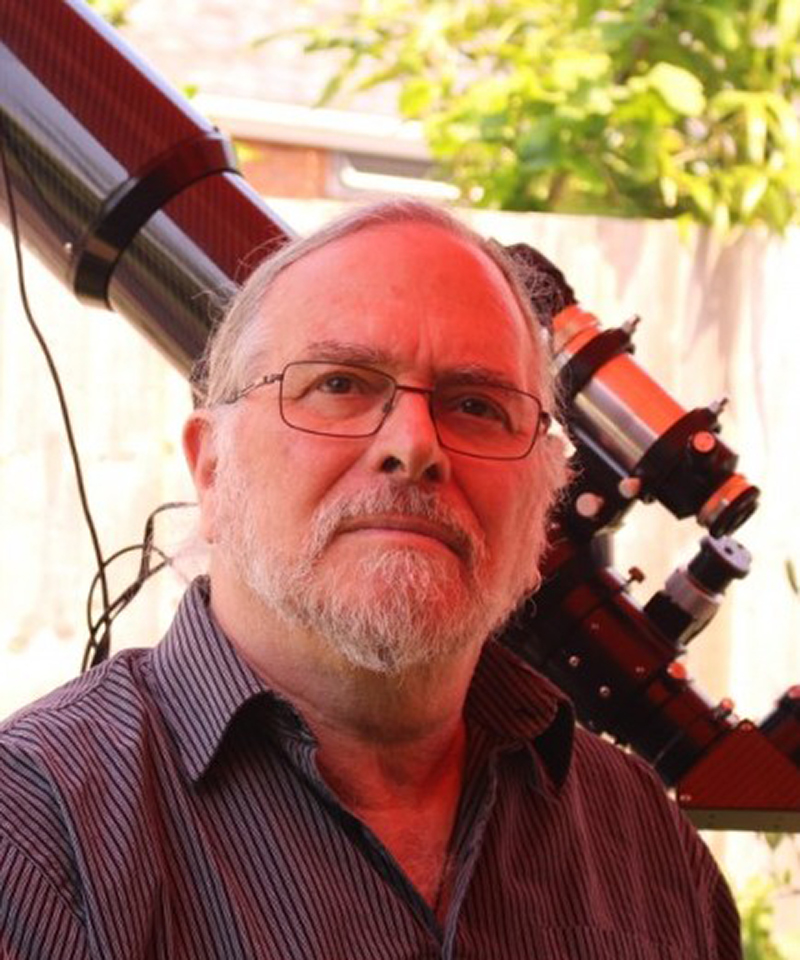Whatever time of year you happen to be reading this, there are bound to be at least a few wonderful targets to see in the night sky tonight with binoculars.
Indeed, there are hundreds of astronomical bodies that a pair of binoculars will bring into view for you.
Not only will binoculars let you see many more objects than you can with the naked eye, but the detail and colour in those objects become a lot richer.
With binoculars, the Coathanger asterism in Vulpecula actually looks like a coathanger and the Orion Nebula becomes a fantastically detailed painting of light.
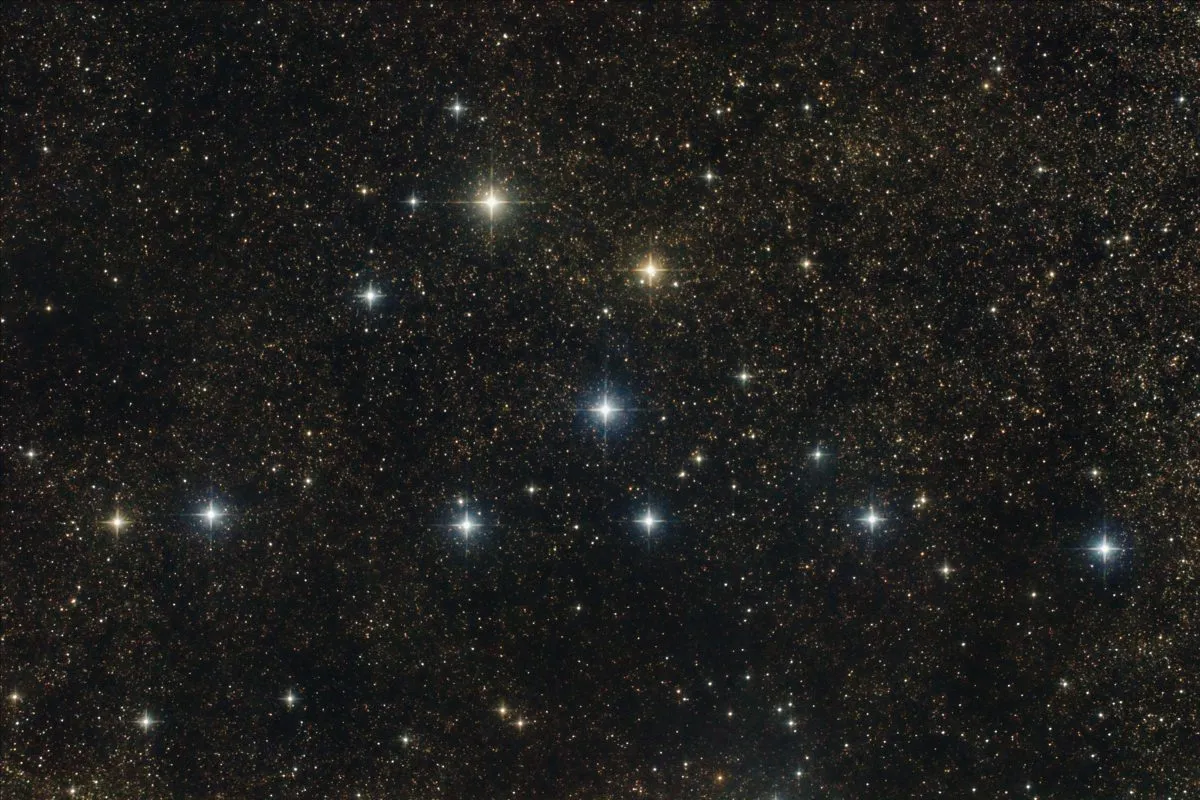
The Milky Way is no longer a tenuous glowing band, but a knotted tangle of stars, interspersed with mysterious dark patches.
Albireo goes from being an ordinary-looking star that marks the head of Cygnus to an exquisite binary juxtaposition of gold and sapphire.
And you can easily see galaxies by the light that left them millions of years ago, when our ancestors were thinking about leaving the trees.
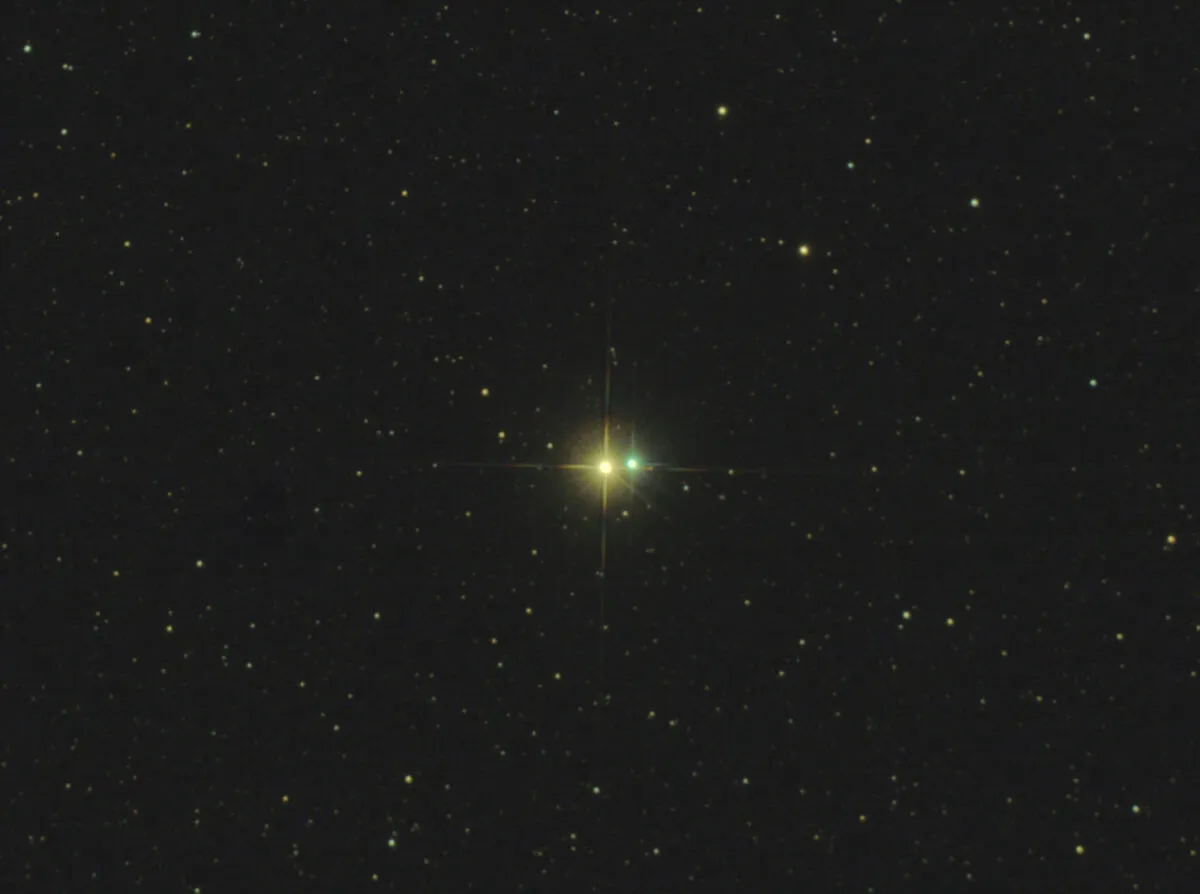
Binoculars are still suitable even if you want to do ‘serious’ astronomy.
There are variable star observing programmes specifically for binoculars, and their portability makes them ideal for taking to the narrow track where a lunar graze or asteroid occultation is visible.
Alternatively, you could wrap up warm, lie back on your garden recliner and just enjoy the objects that the binoculars let you find as you cast your gaze among the stars.
Before you even realise it, you have begun to learn the sky and you’ll soon be able to navigate around it better than the entry-level Go-To telescope you nearly bought instead.
Best of all, you can have this complete observing system for two eyesfor less than the price ofone reasonably good telescope eyepiece.
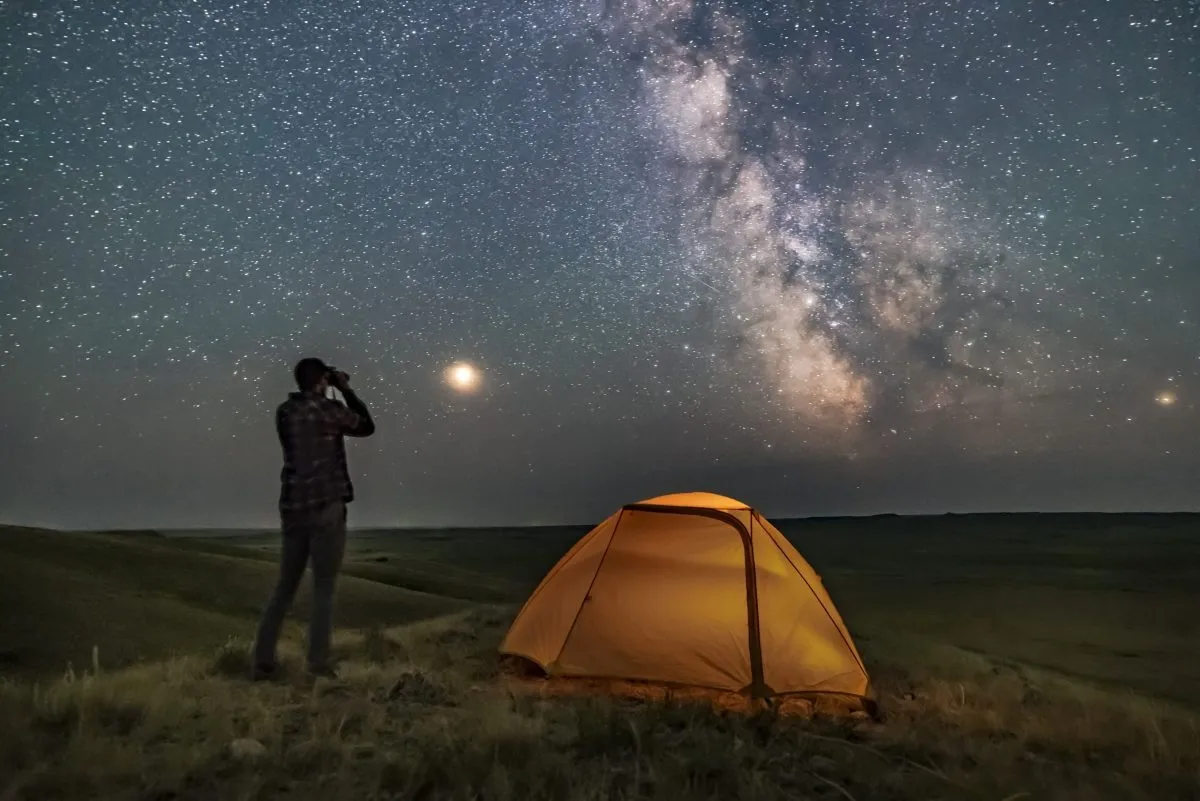
In this guide we'll go through 6 wonderful targets that are visible in the night sky through binoculars.
We'll update the guide every month so you always have something new to observe, and as this archive grows you can scroll back through previous years of the current month and try and find those targets too.
Each binocular tour is made all the easier by downloading our PDF charts, the links for which you can find just at the top of each section below.
The tour charts are black on white, so you can read it under red light and avoid spoiling your night vision.
For more advice, read our guide to stargazing with binoculars, our pick of the best binoculars for astronomy and the best budget binoculars.
6 binocular night-sky targets for December 2025
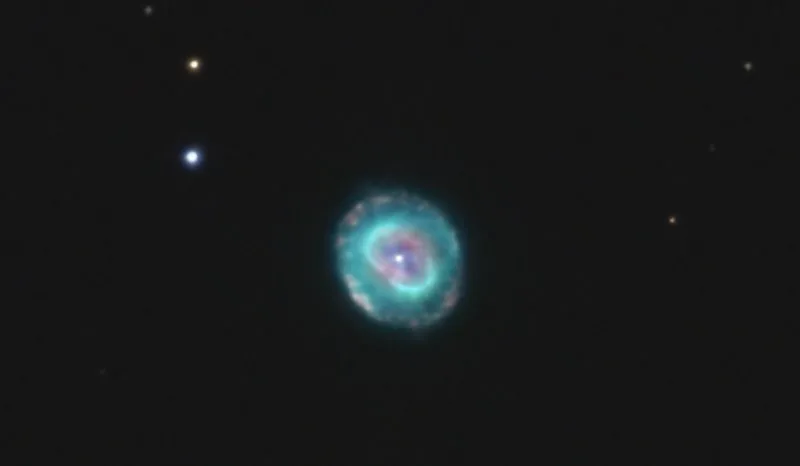
Download our December 2025 binocular tour form (PDF)
1 – The Hockey Stick
Use the chart to identify NGC 752. Near its southwest edge you’ll see the components of the easy double star 56 Andromedae, shining at mag. +5.6 and +5.9. Extending northwest is a 1.6° chain
of sixth and seventh-magnitude stars that form a hockey stick shape; 56 Andromedae is the toe end and NGC 752 is the oversized ball. This is a line-of-sight association: NGC 752 is four times farther away than 56 Andromedae.
2 – The Andromeda Galaxy
If you can’t see this galaxy with your unaided eye, start with mag. +2.0 Mirach (Beta (β) Andromedae) at one side of the field of view and mag. +3.9 Mu (μ) Andromedae at the other. Pan across so that Mu Andromedae is where Mirach was, and the elliptical shape of M31, the Andromeda Galaxy, will appear where Mu was. Can you identify the two companion galaxies, M32 and M110, which look like defocused stars?
3 – The Home Plate
Here’s another sporting asterism. Starting at mag. +4.6 Theta (θ) Andromedae, pan 2.5° (about half a 10x50 field of view) northwest. Here you’ll find an irregular pentagon of yellowish seventh-magnitude stars covering an area of about 0.5° x 0.75°. It looks like the home plate that a baseball batter must touch
to complete a run. Can you identify which three of the corners are multiple stars?
4 – NGC 7686
Begin at mag. +4.1 Kappa (κ) and mag. +3.9 Lambda (λ) Andromedae. Imagine a line connecting the two, then extend that same distance northwards. You’ll arrive at an obvious pair of stars,
5 arcminutes apart. The brighter of the pair, at mag. +6.2, sits at the centre of a 16-arcminute-wide glow: the open cluster NGC 7686. At a distance of 5,000 lightyears, that span translates to around 23 lightyears across.
5 – Honores Friderici
In 1787, the year after Frederick the Great’s death, German astronomer Johann Bode created the now-defunct constellation Honores Friderici (Frederick’s Regalia) to honour him, representing a sword and quill, wreathed in laurel. Binoculars bring out the varied colours of the stars, ranging from the blue-white of Omicron (ο) Andromedae to the orange-red of 8 Andromedae.
6 – NGC 7662
Switch to larger binoculars for this planetary nebula, as they’ll reveal the colour that will help you identify it. From mag. +4.3 Iota (ι) Andromedae, scan 2° west to mag. +5.7 13 Andromedae. NGC 7662 lies 0.5° to the south-southwest, appearing as an eighth-magnitude star with a blue-green hue that sets it apart from the surrounding white stars. Defocus slightly to bring out the colour.
6 binocular night-sky targets for November 2025
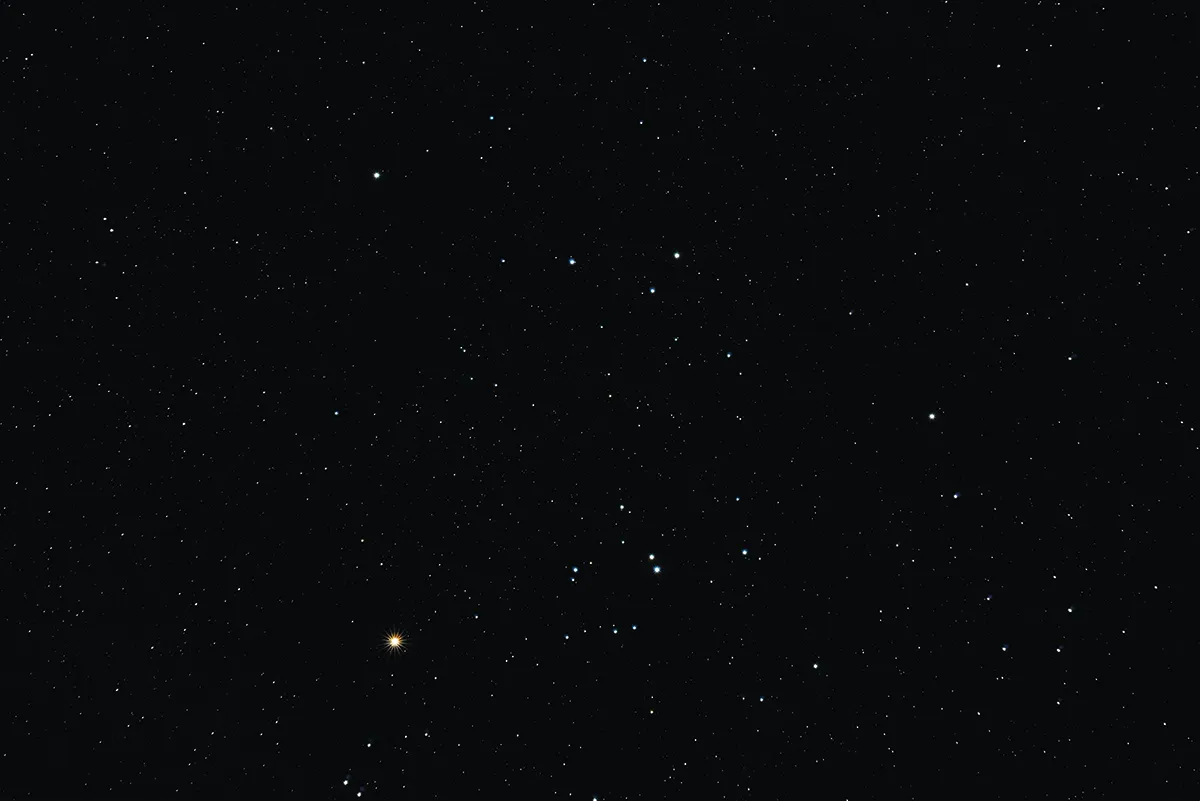
Download our November 2025 binocular tour form (PDF)
1 – The Hyades
The V-shaped Hyades open star cluster is next to mag. +1.0 Aldebaran (Alpha (α) Tauri), the reddish eye of the Bull, a foreground star that’s not actually part of the cluster. At 153 lightyears distant, it’s the nearest open cluster to Earth. In British folklore, the Hyades are the “8 for the April Rainers” in the counting song Green Grow the Rushes, O, referring to spring rains at their final dawn appearance.
2 – NGC 1647
Just 3° northeast of Aldebaran is a delightful little open cluster, NGC 1647. It’s often overlooked because of the presence of its more prominent neighbour. With 10x50 binoculars, you should be able to see eight or nine stars against a background glow a bit bigger than the apparent size of the Moon. Although it’s twice the size of the Hyades, it appears small in comparison because it’s nearly 12 times farther away.
3 – Davis’s Dog
The late Massachusetts astronomer John Davis, who discovered this asterism, saw it as a cosmic beagle. You’ll find it 2.5° northwest of mag. +3.5 Ain (Epsilon (ε) Tauri), covering a region of about 3.5° by 1.5°. Three of the brighter stars, 51, 53 and 56 Tauri, form its head; a string of four, including the wide double star mag. +4.2 and +5.1 Kappa1 (κ1) and Kappa2 (κ2) Tauri, make its tail.
4 – 10, 11 and 14 Arietis
If you look 2.5° north of mag. +2.0 Hamal (Alpha (α) Arietis), you’ll see three pairs of stars in the same field of view. The yellowish components of 10 Arietis are mag. +5.7 and +7.1, separated by 9.5 arcminutes, whereas those of 11 Arietis are +6.0 and +7.3, 7.7 arcminutes apart and distinctly white. The yellow-white components of 14 Arietis are mag. +5.0 and +7.9 and much closer, at 108 arcseconds.
5 – The Cosmic Question Mark
Use the chart to identify mag. +4.9 Nu (ν) Ceti and hold it at the bottom half of your field of view. You’ll see that it’s the point at the bottom of the 2.25°-long question mark asterism. This is a good star-party object, both because of its shape and the varied colours of the sixth- and seventh-magnitude stars that make up the asterism.
6 – A fortuitous Xi group
There are four stars with the Bayer designation Xi (ξ) in this region of sky, each with a different colour. Mag. +5.5 Xi Arietis is bluish white, mag. +4.3 Xi2 Ceti is pure white, mag. +4.4 Xi1 Ceti is distinctly yellowish and mag. +4.6 Xi Piscium is yellow-orange. There are also fainter yellow-white and orange-red stars in the region. Can you find them? (It helps to defocus slightly to reveal the colours.)
6 binocular night-sky targets for October 2025
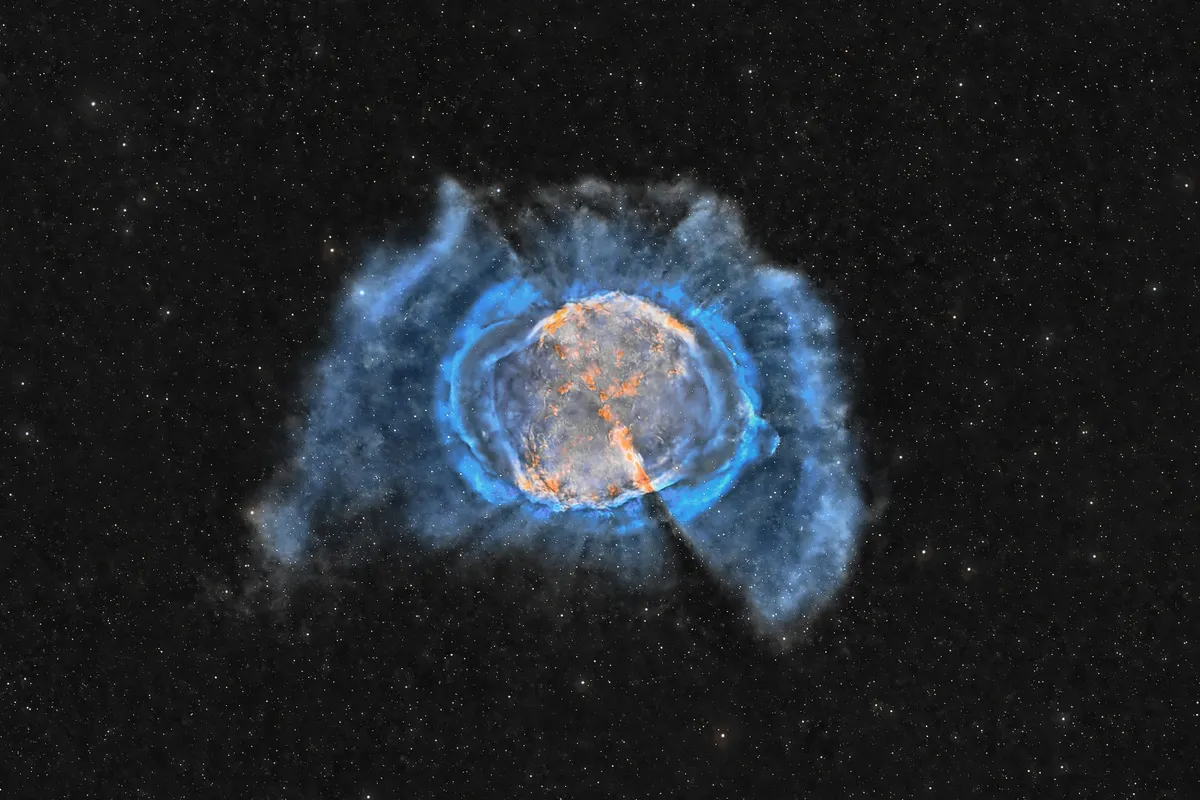
Download our October 2025 binocular tour form (PDF)
1 – NGC 6940
Let’s start the tour with open cluster NGC 6940, which deserves to be far better known. To find it, use the chart to identify mag. +4.2 52 Cygni and pan 3.5° to the southwest to an oval patch of light about 0.5° across. You should be able to resolve about eight or so stars within this patch. NGC 6940 is about 2,700 lightyears distant and is thought to be about 800 million years old.
2 – The Dumbbell Nebula
Our next target is the first planetary nebula ever discovered, and the easiest to spot with binoculars from UK latitudes. Put mag. +3.4 Gamma (γ) Sagittae at the south of your field of view and M27, the Dumbbell Nebula, will be just north of centre: a minuscule rectangular glow. You might make out a slight narrowing in the middle that gives the nebula its common name, though in reality it looks more like an apple core than a dumbbell.
3 – Albireo
The star at the head of Cygnus, mag. +3.1 Albireo (Beta (β) Cygni) is a very pretty double. The yellow primary has a blue-white mag. +5.1 secondary 34 arcseconds away, making it a good test for the quality of 10x50 binoculars, which you may need to mount to split the pair. Whether it’s a true binary or a line-of-sight pairing has been long debated.
4 – The Cooling Tower
M29 lies about 2° south of mag. +2.2 Sadr (Gamma (γ) Cygni). This 7-arcminute misty patch is unremarkable in smaller binoculars, but 15x70s should reveal at least seven ninth-magnitude stars that form its cooling tower shape. The cluster of hot, young blue-white stars lies 6,000 lightyears away and is hurtling towards us at 28km a second.
5 – The North America Nebula
The North America Nebula (NGC 7000) is a large, bright patch of nebulosity with its centre about 3.5° east-southeast of mag. +1.3 Deneb (Alpha (α) Cygni). In ideal conditions, it’s visible to the unaided eye as a slightly brighter patch of sky. If you’re having trouble detecting it, see if you can make out the dark patch that forms the neighbouring ‘Gulf of Mexico’, which may be more readily apparent.
6 – The Eastern Veil Nebula
This month’s big challenge is NGC 6992, the brightest part of the Veil Nebula complex, a huge supernova remnant. It’s slightly less than 1° south of the centre of a line joining mag. +2.5 Aljanah (Epsilon (ε) Cygni) and mag. +3.2 Zeta (ζ) Cygni. To give yourself the best chance of seeing this ghostly curved glimmer, choose a clear, moonless night and mount your binoculars. Even then, you’ll need to use averted vision – and be very patient!
6 binocular night-sky targets for September 2025

Download our September 2025 binocular tour form (PDF)
1 – Psi Aquarii group
This colourful grouping of stars spans nearly 5° of sky, from mag. +5.0 Psi3 (ψ3) Aquarii to mag. +5.6 96 Aquarii.
The colours range from blue-white mag. +5.5 Psi2 (ψ2) Aquarii (spectral type B) to orange-red mag. +4.2 Phi (φ) Aquarii (spectral type M), with all the intervening spectral types (AFGK) represented. Can you arrange them in colour order and identify which star is which spectral type?
2 – M2
Our next target, the globular cluster M2, is easy to find due north of mag. +2.9 Sadalsuud (Beta (β) Aquarii) and due west of mag. +2.9 Sadalmelik (Alpha (α) Aquarii).
It is obvious in a star-sparse region of sky and you may see it as Charles Messier himself did: “a nebula without stars.” If you use averted vision (direct your gaze away from it), it will appear to grow slightly and may seem very slightly oval.
3 – Hebe
6 Hebe is the fifth-brightest asteroid and is thought to be the source of around 40 per cent of the meteorites that strike Earth. Use the chart at the link above to locate it as it moves southwest, shining at mag.+7.7 early in the month.
Although it dims by about half a magnitude later in September, this is offset by the departure of the bright Moon. Track it against the many stars near its path.
4 – The Helix Nebula
A transparent sky, a clear southern horizon and full dark adaptation are prerequisites to get a good look at planetary nebula NGC 7293, the largest visible from the UK. Use the chart at the link above to identify mag. +5.2 Upsilon (υ) Aquarii.
Look slightly more than 1° to the west, where you should see a faint disc about 13 arcminutes in diameter. Once you have identified it, see if averted vision will reveal any slight brightening to the north.
5 – M30
Our second globular cluster is smaller, fainter and lower in the sky than M2. Find mag. +5.2 41 Capricorni and the cluster is 0.5° to the west, looking like a defocused star.
If you want to try a ‘Messier marathon’ next spring (observing all the Messier objects between dusk and dawn), M30 is among the most difficult. Late summer evenings are a very good time to practise finding it!
6 – The Saturn Nebula
NGC 7009 is a good observing challenge in UK skies, for which you’ll need the same conditions as you did for the Helix. Fortunately, it’s simple to locate, 1.3° due west of mag. +4.5 Nu (ν) Aquarii.
It will look like a slightly defocused star; to detect the elongated lobes that confer its similarity to Saturn would call for considerably more magnification, averted vision and a UHC or OIII filter.
6 binocular night-sky targets for August 2025
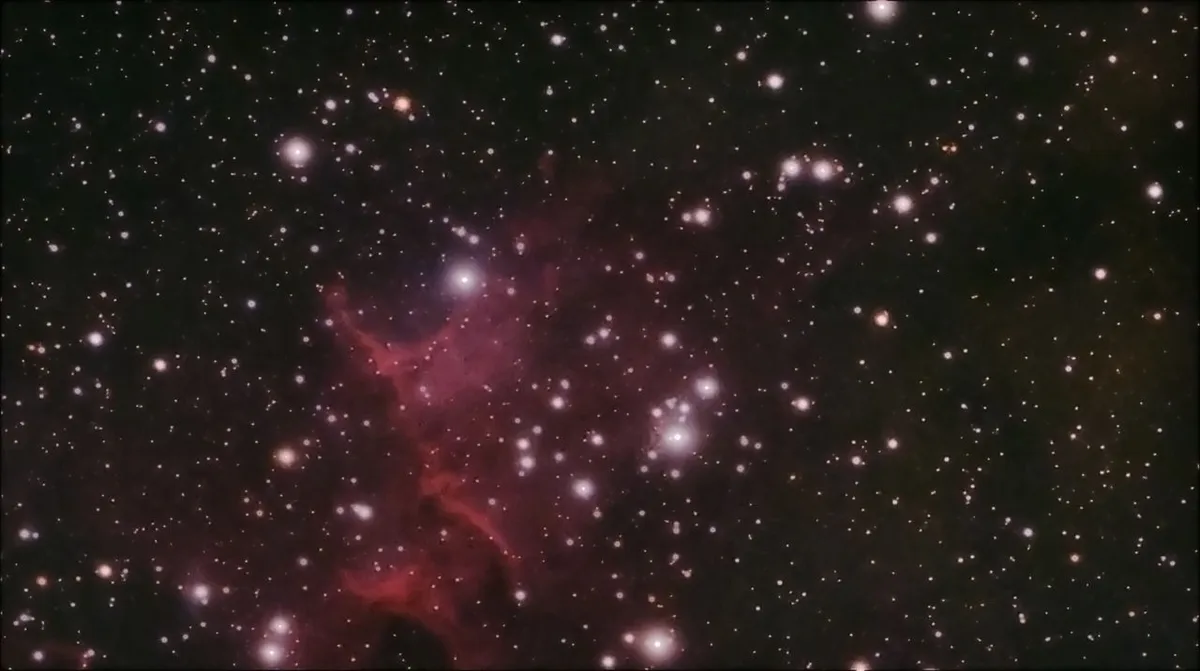
Download our August 2025 binocular tour form (PDF)
1 – The Perseus Double Cluster
A third of the way from mag. +3.8 Miram (Eta (η) Persei) to mag. +2.6 Ruchbah (Delta (δ) Cassiopeiae), you will find a close pair of open clusters. The pair may be visible to your naked eye, but large binoculars will help you to experience the 3D illusion that makes it so attractive.
Those stars are intrinsically far brighter than our Sun, which, if it were at that distance, with these binoculars would be too faint to be seen!
2 – The Muscleman Cluster
From the part of the Double Cluster that is nearest Cassiopeia, there is a 2° curved chain of eighth-magnitude stars leading to the north. They guide you to Stock 2, the Muscleman Cluster.
You will recognise it from the sparse X-shaped pattern of brighter stars which, on closer observation, have the form of a stick man who is flexing his biceps and apparently keeping the Double Cluster on a leash.
3 – Melotte – 15
Melotte 15 marks the southeastern apex of an equilateral triangle with mag. +3.3 Segin (Epsilon (ε) Cassiopeiae) and mag. +4.6 Iota (ι) Cassiopeiae. You should be able to resolve at least half a dozen stars in a narrow ‘V’ shape from this bright, large glow.
Unless you have exceptional skies, you are unlikely to be able to detect the surrounding nebulosity (IC 1805, the Heart Nebula) that gave birth to the cluster.
4 – Pazmino’s Cluster
Navigate 1.5° due west from mag. +4.2 CS Camelopardalis to find a little trapezium of seventh- and eighth-magnitude stars. This is Stock 23, also known as Pazmino’s Cluster, named for John Pazmino who popularised it in the 1970s.
In 50mm binoculars, it’s much more than a trapezium; depending on your sky conditions, you may be able to resolve half a dozen stars against a 10-arcminute-diameter glow.
5 – Beta Camelopardalis
Beta (β) Camelopardalis is easily visible to your naked eye at mag. +4.0. It has a mag. +7.4 companion 84 arcseconds to the southwest.
Beta Cam is classified as a yellow supergiant and is a relative youngster at a mere 40 million years old. Keep an eye on it – you may see it brighten by a whole magnitude in a 0.25-second flash, possibly its equivalent of a huge solar flare.
6 – The ‘Other Double Cluster’
A couple of 15x70 fields of view (8°) east of mag. +1.8 Mirphak (Alpha (α) Perseii), you’ll see the obvious cluster NGC 1528, which is rich and compressed.
Its companion, NGC 1545, which lies slightly more than a degree southeast, is smaller, sparser and marginally brighter. They are both about 2,500 lightyears away and so offer a good example of the variety that exists in open clusters.
6 binocular night-sky targets for July 2025
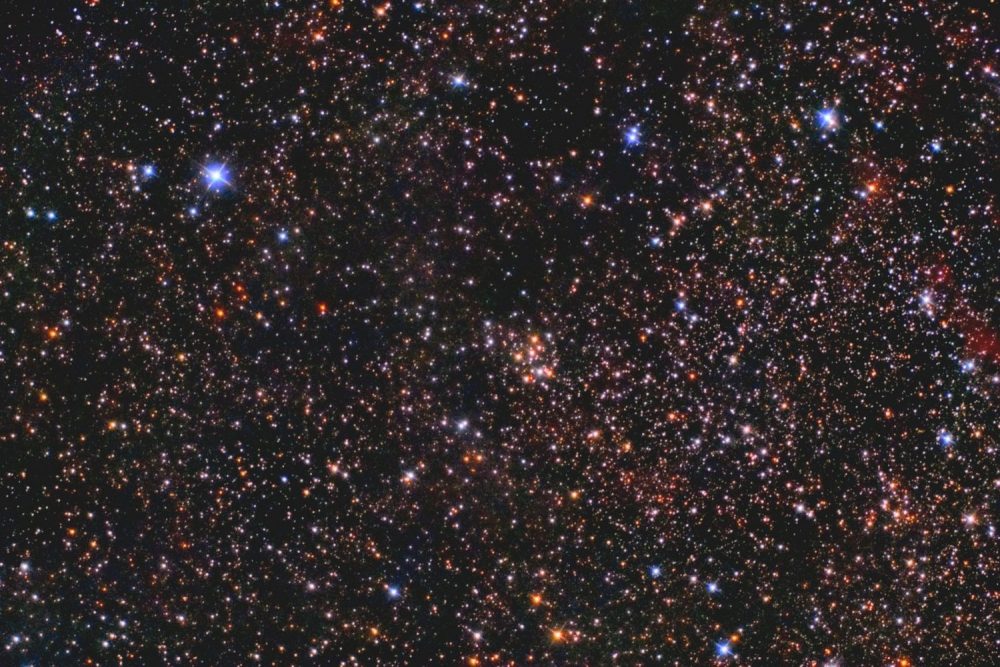
Download our July 2025 binocular tour form (PDF)
1 – Stephenson 1
Stephenson 1 is a cluster that deserves to be better known. Delta (δ) Lyrae is a very wide (10-arcminute) and bright (mag. +4.3 and + 5.6) double star with a stunning colour contrast.
It’s not a true double: the difference in distance is about 200 lightyears. The open cluster Stephenson 1 lies immediately southwest of the pair, appearing as a granular patch of sky. Averted vision will reveal its brighter stars.
2 – Barnard 144
Also known as the Fish on a Platter, this is the dark nebulosity that surrounds mag. +3.9 Eta (η) Cygni. It is named after 'the man who never slept', astronomer EE Barnard, whose study of Yerkes Observatory photographs of what were thought to be holes and voids in the Milky Way led him to realise their true nature: foreground patches of obscuring gas and dust, which he subsequently catalogued.
3 – M29
Although you can easily see this distinctive open cluster in small binoculars, its size (7 arcminutes diameter) really lends itself to more magnification. Put mag. +2.2 Sadr (Gamma (γ) Cygni) at the north of the field of view and the cluster will be near the centre.
Depending on your sky conditions, you should see up to 20 stars, including two arcs of brighter ones that form a distinctive ‘power station cooling tower’ shape.
4 – The Northern Coalsack
Very slightly to the east of a line from mag. +1.3 Deneb (Alpha (α) Cygni) to Sadr is B348, one of several regions that is sometimes called the Northern Coalsack. This is another of EE Barnard’s catalogued dark nebulae.
There are several more scattered through the Milky Way and scanning with binoculars while it is high in the sky is a fruitful way of discovering some of these for yourself.
5 – The North America Nebula
The North America Nebula (NGC 7000) is a large, bright patch of nebulosity whose centre is about 3.5° east-southeast of Deneb. If you find it difficult to find, try instead to detect the dark nebula that forms the ‘Gulf of Mexico’ (or ‘Hudson’s Bay’, depending on your perspective).
This emission nebula is about 100 lightyears across and appears to us as four times as big as the Moon.
6 – Orion’s Daughter
Use the chart to locate mag +5.1 56 Cygni. Around 1° southeast lies a pair of seventh-magnitude stars about 10 arcminutes apart. These are the ‘knees’ of a tiny Orion-shaped seven-star asterism.
The ‘belt’ is three ninth-magnitude stars north of the knees, and the widely spaced ‘shoulders’ are a similar distance further north. The left-hand shoulder marks the tip of ‘Florida’ in NGC 7000.
6 binocular night-sky targets for June 2025
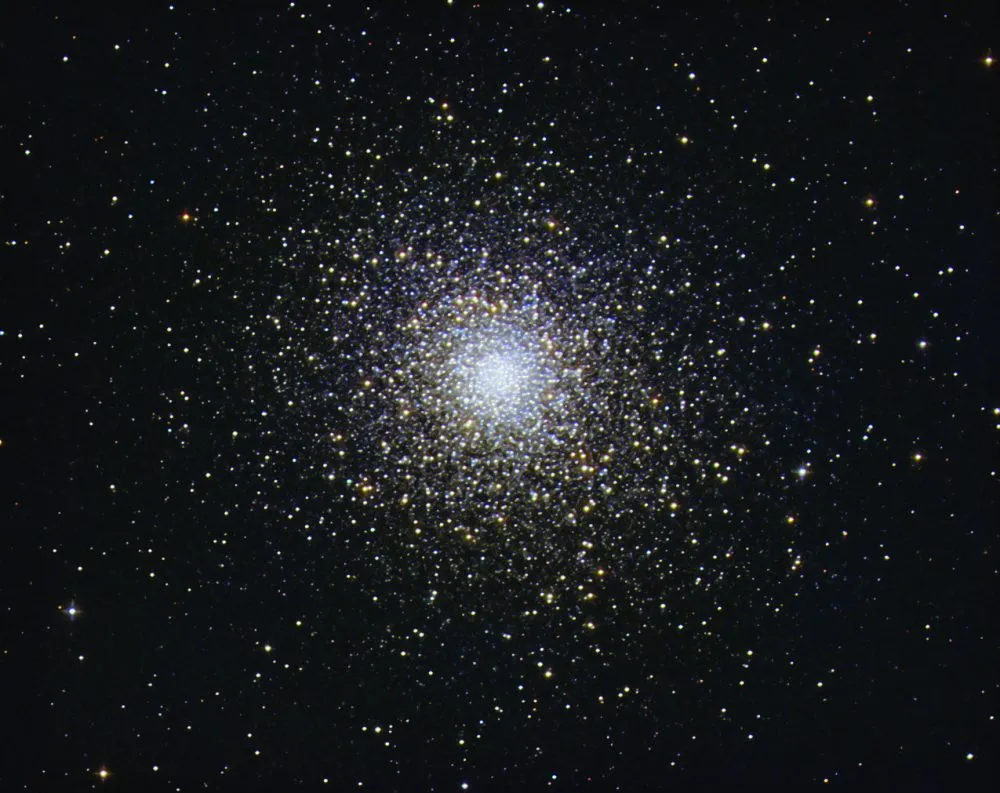
Download our June 2025 binocular tour form (PDF)
1 – The Horn of Plenty
Look 2° northwest of mag. +4.2 Kang (Kappa (κ) Virginis) to see a little trio of stars, the brightest of which is mag. +5.5 95 Virginis. This marks the convergence of two irregular long arcs of stars that create a horn-shaped asterism extending about 12° to the northwest. In mythology, Virgo is often depicted as carrying an ear of wheat, marked by mag. +1.1 Spica (Alpha (α) Virginis), and a cornucopia. Is this the latter?
2 – Vesta
Vesta, the fourth asteroid to be discovered (in 1807 by Heinrich Olbers), was named after the Roman goddess of the hearth by mathematician Carl Friedrich Gauss, whose calculations confirmed the orbits of early asteroid discoveries. In June, watch it travel a tight arc from mid-way between mag. +4.8 Phi (φ) Virginis and mag. +5.4 106 Virginis, finishing near the latter as it fades by half a magnitude from mag. +6.5.
3 – M5
This globular cluster is adjacent to mag +5.0 5 Serpentis and may just be visible to your naked eye if you have a dark, transparent sky. Its stars are deficient in heavy elements and among the oldest stars you can see; they’re thought to have formed soon after our Galaxy. With 10x50 binoculars, you’ll see that this fifth object in Messier’s catalogue of non-comets brightens towards the centre, just like a comet does.
4 – Delta Librae
The variable (mag. +5.8 to mag. +4.4) Delta (δ) Librae lies just over halfway from M5 to Zubenelgenubi (Alpha (α) Librae). It is an eclipsing binary star, that is, a pair of stars in orbit around their common barycentre, with the orbital plane approximately along our line of sight. It has a period of 2.3 days so, even with the short summer nights, you should have several opportunities to notice its magnitude change.
5 – Xi1/Xi2 and 17/18 Librae
Between Delta Virginis and Zubenelgenubi lie two easy pairs of stars. The very wide pair of orange stars are mag + 5.8 Xi1 (ξ1) and mag. +5.4 Xi2 (ξ2) Librae, separated by 0.75°. Half a degree northeast of Xi2 is the other pair, mag. +6.6 17 and mag. + 5.8 18 Librae, nearly 10 arcminutes apart. These are ‘visual binaries’, line-of-sight illusions, and neither pair is physically related.
6 – KX Librae
From Zubenelgenubi, navigate 5.5° towards mag. +3.3 Brachium (Sigma (σ) Librae) to find a mag +5.8 deep-yellow star. Look closer and you’ll see it appears to be a double, with an eighth-magnitude companion 26 arcseconds to the northwest. This fainter companion is actually a pair of red dwarf stars. Recently, a brown dwarf companion was confirmed, making this a quadruple system!
6 binocular night-sky targets for May 2025
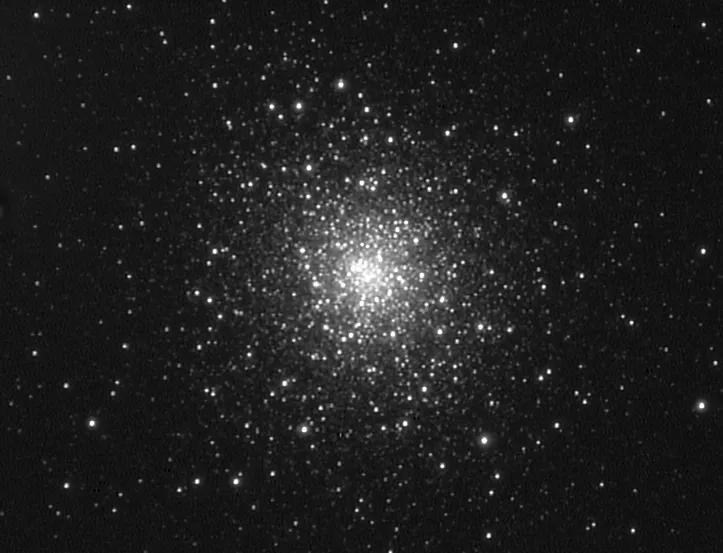
Download our May 2025 binocular tour form (PDF)
1 – 30 Herculis
The distinctly orange star 30 Herculis lies 1° to the west-southwest of mag. +4.2 Sigma (σ) Herculis. The magnitude of this semi-regular variable SRb-type star has recently been changing between about mag. +4.4 and mag. +6.3, with a period of 62–89 days between maxima. Despite being a similar mass to the Sun, this red giant has a radius larger than Earth’s orbit, giving us an indication of how the Sun will evolve.
2 – Great Globular Cluster in Hercules
M13 is called the Great Globular Cluster with good reason and is just visible to the naked eye with averted vision in a dark, transparent sky. Even with small binoculars, this mag. +5.8 cluster can be visible under urban skies, although not nearly as splendidly as it appears in darker conditions. The 400,000 stars that comprise this 145-lightyear-diameter cluster lie about 22,000 lightyears away.
3 – M92
There are many fine objects that are under-observed because of their proximity to a more famous one. Thanks to M13, globular cluster M92 is one of these. To find it, go two-thirds of the way from mag. +3.5 Eta (η) Herculis to mag. +3.8 Iota (ι) Herculis. M92’s 300,000 or so stars are concentrated into an apparent diameter about half that of the Moon. Although not as bright as M13, it handles light pollution quite well.
4 – Cat’s Eye Nebula
The Cat’s Eye Nebula, NGC 6543, marks the position of the North Ecliptic Pole, the centre of the circle that the North Celestial Pole makes in its 25,770-year precessionary cycle. It’s near the centre of a line joining white mag. +3.2 Aldhibah (Zeta (ζ) Draconis) to yellow mag. +3.1 Altais (Delta (δ) Draconis), appearing like an ethereal green star that winks at you if you change from direct to averted vision.
5 – UX Draconis
Using the chart, identify the mag. +5.1 star 59 Draconis. With it centred, look 0.75° east where there’s a very red star. This is UX Draconis, which varies irregularly by more than a magnitude (from mag. +5.9 to +7.1), with a period of 175 days. But we’re here for the colour; carbon in UX Draconis’s atmosphere makes it one of the reddest stars anywhere in the night sky.
6 – Edasich star fields
Edasich is the name for mag. +3.3 Iota (ι) Draconis. Just to the north of it is a group of mostly sixth- and seventh-magnitude stars (with a sprinkling of fainter ones) that extends for about 3°. To the south lies a slightly sparser group. It’s very rewarding to spend time examining them; there are several binocular double and triples, with colour varieties ranging from orange to blue.
6 binocular night-sky targets for April 2025
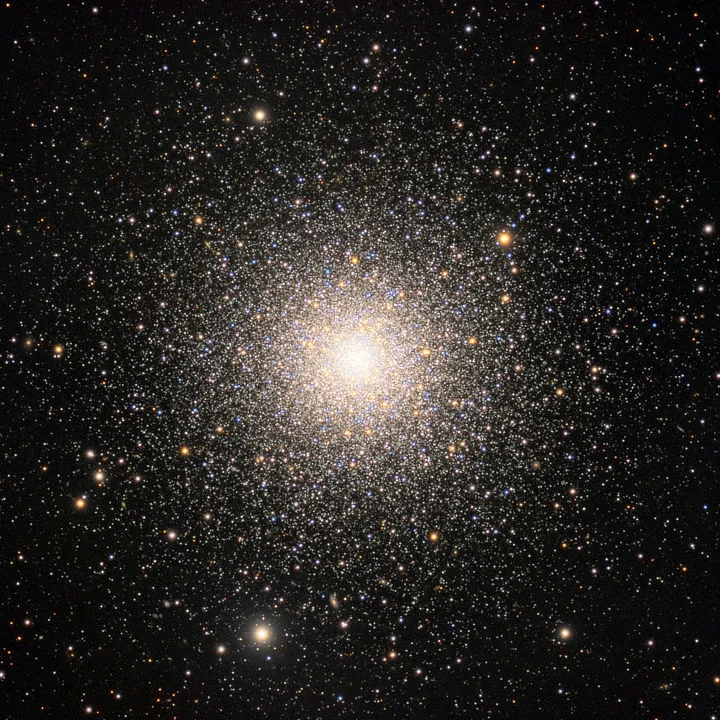
Download our April 2025 binocular tour form (PDF)
1 – M3
We’ll start the tour with one of the best globular clusters in the northern sky. There are no nearby bright stars to help you find it.
However, if you look mid-way between Arcturus (Alpha (α) Boötis) and mag. + 2.9 Cor Caroli (Alpha (α) Canem Venaticorum), you should find what looks like a badly focused star. This is the glow of the nearly half-million stars of globular cluster M3.
2 – M53
Our next globular cluster lies 1° north-east of mag. +4.4 Diadem (Alpha (α) Comae Berenices). This tiny misty patch will appear to grow in size, fuzziness and brightness if you centre it in the field of view and then avert your gaze back to Diadem.
This is M53, and the apparent changes you just witnessed show the difference between direct and averted vision. You’ll find this technique useful when we look at galaxies later in the tour.
3 – FS Comae Berenices
Go to a point mid-way between Diadem and mag. +4.2 Beta (β) Comae Berenices, then look 1° to the west, where you’ll find an orange star, FS Comae Berenices, shining somewhere around mag. +6.
The magnitude of this semi-regular variable star fluctuates between +6.1 and +5.3, with a period of 55–58 days. The star’s spectrum shows varying Doppler shifts, suggesting that its variability is due to pulsations in size.
4 – The Black Eye Galaxy
Its high surface brightness means that under dark, transparent skies it’s fairly easy to see mag. +8.5 galaxy M64. Find this elongated oval glow 1° east-northeast of mag. +5.0 35 Comae Berenices.
With averted vision, its long axis appears about a quarter of the apparent diameter of the Moon, but you won’t see the dark dust lane that gives it its common name, the Black Eye Galaxy.
5 – M49
Find Rho (ρ) Virginis and place it on the north-east of your field of view. On the opposite side, you should find a small, slightly oval patch of light between a pair of sixth-magnitude stars, just over a degree apart and orientated southeast–northwest.
This is the 37-million-year-old light of galaxy M49. Try averted vision again to see how many more galaxies you can detect in this region of sky.
6 – Leo’s Double Double
Use the chart to locate mag. +4.9 star Tau (τ) Leonis and its fainter companion, mag. +6.5 83 Leonis 20 arcminutes to the north-west. If you look carefully, you’ll see each of these is itself a double star with a mag. +7.5 companion.
Tau’s pale companion is easier to discern at 1.5 arcminutes but, at only 29 arcseconds, splitting 83 Leo is a tough challenge for 10x50 binoculars.
6 binocular night-sky targets for March 2025
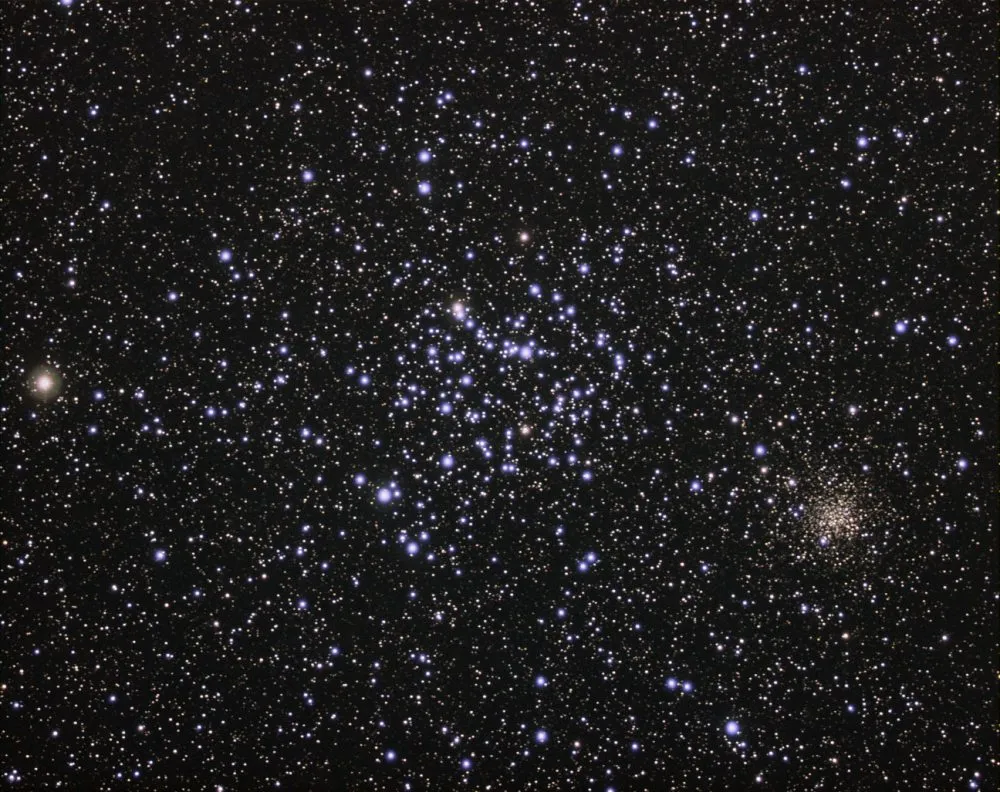
Download our March 2025 binocular tour form (PDF)
1 – The Leaping Minnow
You’ll find the first of this month’s asterisms (star patterns) a little more than 4° east of mag. +2.7 Hassaleh (Iota (ι) Aurigae). This little group of fifth-magnitude stars, just over a degree long, includes 14, 16, 17, 18 and 19 Aurigae. In a pair of 10x50 binoculars (and with a bit of imagination), you should see that this group of stars forms the shape of a fish leaping out of the water.
2 – The Cheshire Cat
Look 1.5° to the east of the Leaping Minnow and you’ll easily see yellow mag. +5.1 Phi (φ) Aurigae. This is the brightest star in a northeast-extending curve of mostly sixth and seventh-magnitude stars that covers about 1.5°. This is Alice’s “grin without a cat”. There’s a pair of widely spaced stars – the cat’s yellowish eyes – 0.5° to the west. Can you see the little group of eighth-magnitude stars that hints at the disappearing nose?
3 – The Auriga trio of clusters
At the northern end of the Cheshire Cat’s smile, there’s a fuzzy patch. That is M38, known as the Starfish
Cluster, the first of three easy open clusters in Auriga. You’ll find the next one, the Pinwheel Cluster, M36, a couple of degrees to the southeast. Now place M36 at the northwest of your field of view and yet another fuzzy patch, the Salt and Pepper Cluster, M37, will be just to the left of centre.
4 – M35, the Queen of Clusters
Use the chart to identify the mag. +2.9 star Tejat (Mu (μ) Geminorum) and the mag. +3.3 star Propus (Eta (η) Geminorum). M35 occupies the third apex of a base-up isosceles triangle, with the two stars at the other. This aptly named Queen of Clusters is about the same apparent size as the Moon, and even under suburban skies you should be able to resolve at least 10 stars with 10x50 binoculars.
5 – Mekbuda
The period of a Cepheid variable star is proportional to its luminosity, so by measuring its period you can determine its distance by comparing its luminosity with its magnitude. Mekbuda (Zeta (ζ) Geminorum) is such a star; it varies between mag. +3.6 and +4.2 over 10.15 days, so you could easily obtain a light curve within a month.
6 – The Little Crab
Flemish astronomer Petrus Plancius created some new constellations to fill in gaps between the original 48 Greek ones. For a few decades in the 16th century, Cancer Minor, the Lesser Crab, 10° east of Mekbuda, was one of these. This pretty asterism of colourful fifth-magnitude stars extends nearly 7° from mag. +5.4 85 Geminorum to mag. +5.3 68 Geminorum, looking more like a fletched arrow than a crab.
6 binocular night-sky targets for February 2025
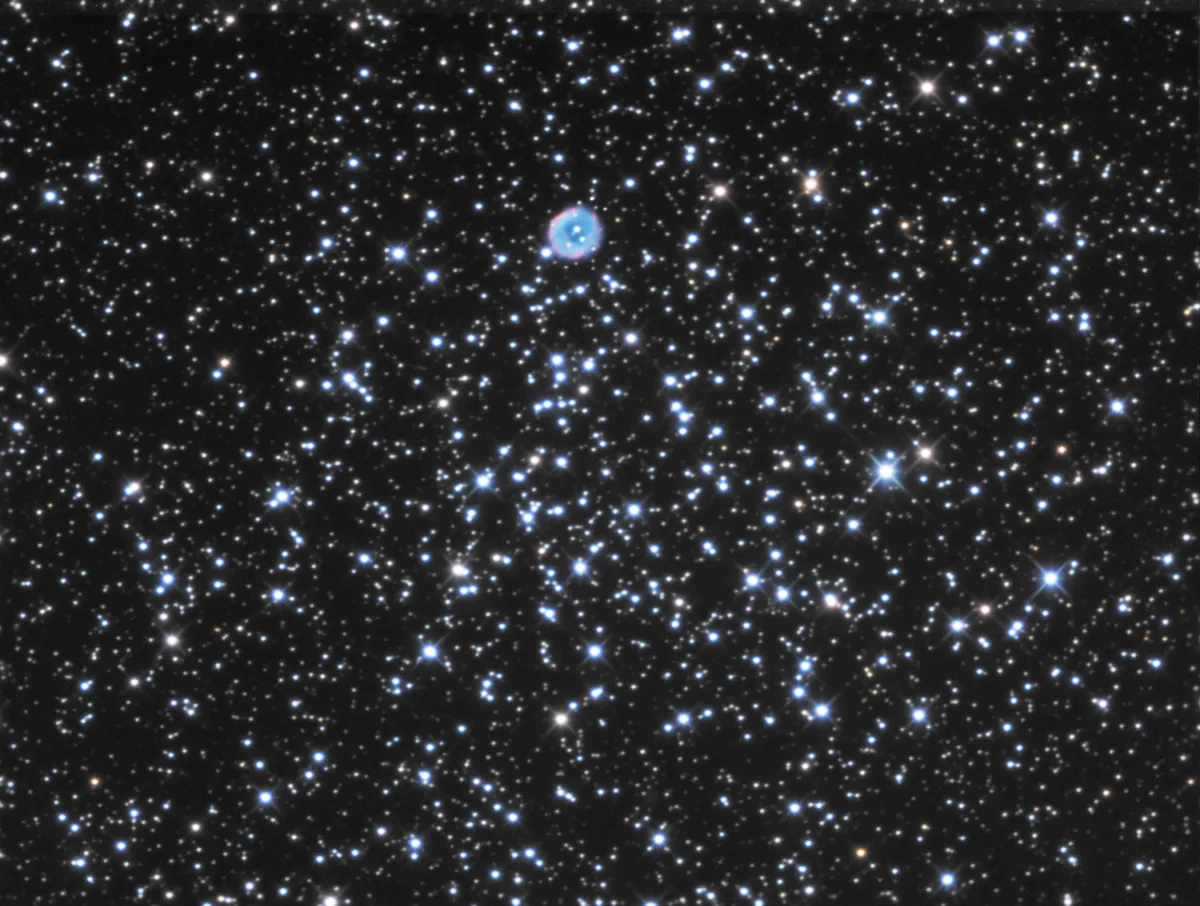
Download our February 2025 binocular tour form (PDF)
1 – M50
We start this month’s tour with M50, one of several open clusters we’ll visit this month. An easy way to find this lovely cluster is to navigate just over 5° north-northeast from mag. –1.1 Sirius (Alpha (α) Canis Majoris) to the mag. +4.0 star Theta (θ) Canis Majoris, then continue another 4° in the same direction.
You’ll see M50 as a circular glow about half the apparent diameter of the Moon. M50 lies 3,200 lightyears away and spans approximately 20 lightyears.
2 – M46 and M47
This contrasting pair of clusters lie together in the same field of view, 5° to the south of mag. +3.9 Alpha (α) Monocerotis. You should easily be able to resolve over half a dozen stars in M47.
M46 is over three times as far away at 5,500 lightyears, but is a similar apparent size. It’s larger and contains many more stars than M47, but you probably won’t be able to resolve any of them.
3 – M41
M41 is 4° south of Sirius and is visible to the naked eye. It appears larger than our previous clusters, and with 10x50 binoculars you should be able to resolve up to 10 brighter stars against the background glow of fainter stars if you use averted vision.
If the sky is transparent enough, you may be able to detect differing star colours, with the brightest one, near the centre, being somewhat orange.
4 – Omega Canis Majoris group
Mag. +4.0 Omega (ω) Canis Majoris lies 1.5° east of mag. +1.8 Wezen (Beta (β) Canis Majoris). It’s a brilliant white compared to the fainter yellowish star that is just to the south of it.
Both are part of the very attractive C-shaped ‘dog’s tail’ of stars of varying colour that extends from mag. +5.9 26 Canis Majoris in the north, through 27 Canis Majoris and Omega Canis Majoris, to a mag. +5.4 yellow star 1° south of Wezen.
5 – NGC 2362 and UW Canis Majoris
Use the chart to locate the brilliant blue-white mag. + 4.4 Tau (τ) Canis Majoris at the centre of the very tight open cluster NGC 2362. The slightly fainter, but otherwise similar, UW Canis Majoris lies less than half a degree north of Tau. However, every 4.39 days the brightness falls by half a magnitude from +4.8 as this blue supergiant is eclipsed by its fainter, smaller companion.
6 – The ‘Winter Albireo’
With UW Canis Majoris near the bottom of the field of view, you’ll see a contrasting yellow star near the centre. This is the ‘Winter Albireo’, mag. +4.8 HD 56577. This star-party piece looks similar to the summer favourite Albireo (Beta (β) Cygni).
A close double, at 27 arcseconds apart, it’s tighter than its summer cousin so use 15x70s to separate it from its mag. +5.8 white companion.
6 binocular night-sky targets for January 2025
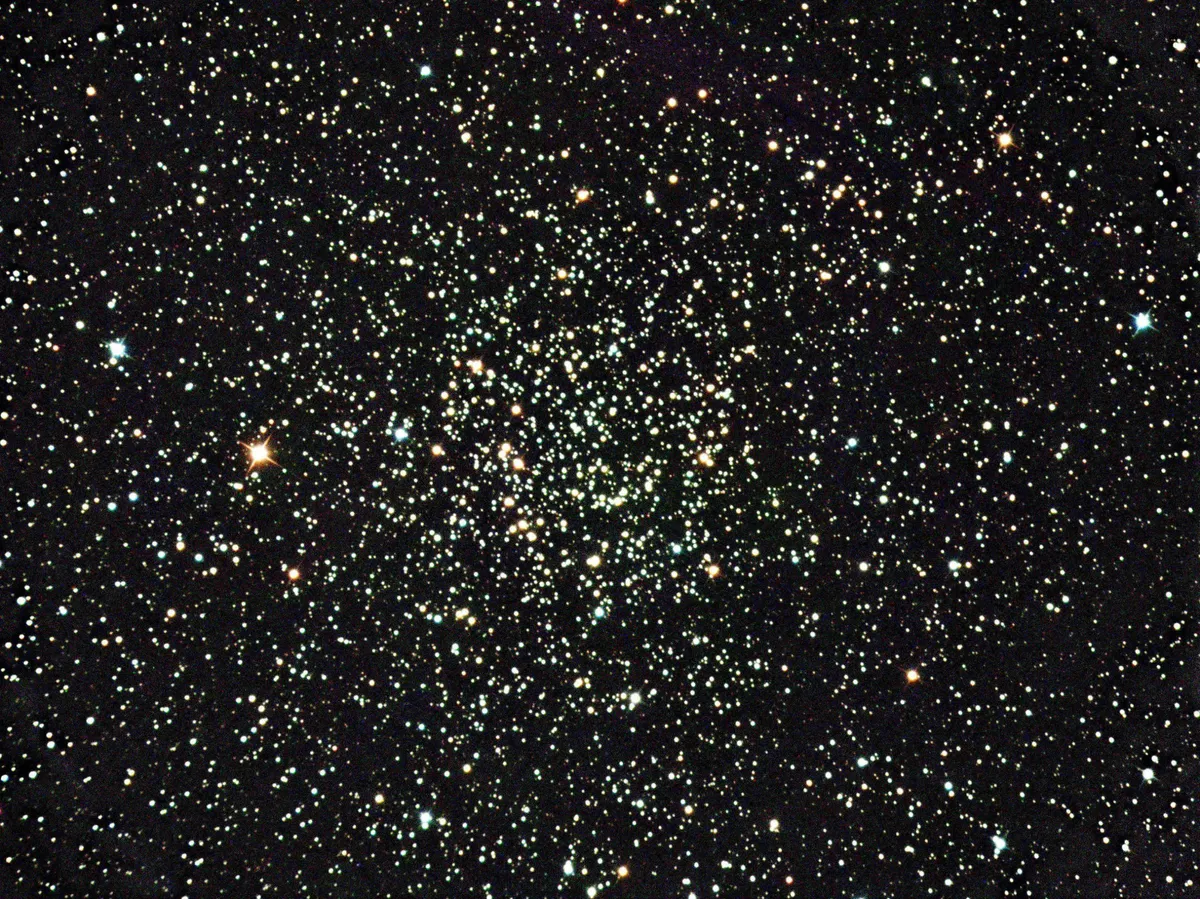
Download our January 2025 binocular tour form (PDF)
1 – The Queen’s Aeroplane
Locate golden-yellow mag. +5.0 4 Cassiopeiae, which marks the starboard wingtip of this little aeroplane-shaped asterism (pattern of stars). The other wingtip, a degree to the west, is the mag. +6.6 blue-white V649 Cassiopeiae. The curved ‘fuselage’ of stars that shine at mag. +8.0 or brighter extends a degree northwards to a mag. +6.7 orange-red star. There’s a lovely variety of star colours here, which a dark transparent sky will help you to appreciate.
2 – Caroline’s Rose, NGC 7789
Caroline Herschel discovered our next target in 1783. You’ll find it between mag. +4.5 Rho (ρ) and mag. +5.1 Sigma (σ) Cassiopeiae. You won’t be able to resolve any stars, even using averted vision, but you should see a soft glow about half the apparent diameter of the Moon. Caroline’s Rose is estimated to be about a billion years old, which is unusually old for an open cluster.
3 – Eddie’s Coaster
This asterism was discovered by, and is named after, the West Country amateur astronomer Eddie Carpenter. Given that it’s difficult to identify on a star chart or app, Eddie’s Coaster is surprisingly obvious in 10x50 binoculars. Look 3° north of Gamma (γ) Cassiopeiae to find a 3°-long wave of seventh and eighth-magnitude stars, reminiscent of a rollercoaster. Cast around the area; you too may find a pattern of interest.
4 – The Owl Cluster, NGC 457
Start at mag. +2.6 Ruchbah (Delta (δ) Cassiopeiae) and navigate 2° southwest to mag. +5.0 (Phi (φ) Cassiopeiae) and its mag. +7.0 companion 2 arcminutes further on. These are the owl’s eyes. Its body and wings are composed of ninth and 10th-magnitude stars that span an area about 0.25° in the direction of γ Cassiopeiae. The owl’s brighter eye is not a cluster member, lying only half as far away.
5 – Cassiopeia triple cluster: NGC 654, NGC 659 and NGC 663
Look 0.5° east of the middle of an imaginary line joining Ruchbah and mag. +3.3 Segin (Epsilon (ε) Cassiopeiae)and you’ll easily find the brightest of these clusters, NGC 654. Slightly less than 1° to the south-southeast is the larger but fainter NGC 663. Your challenge is to spot the tiny ghostly glow of NGC 659, just on the NGC 663 side of the mag. +5.8 44 Cassiopeiae.
6 – Kemble’s Kite
From Segin, take a line through mag. +4.6 Iota (ι) Cassiopeiae and extend it 7° to mag. +6.4 V805 Cassiopeiae, which will look deep yellow in binoculars. It’s the brightest of a 1.5°-long asterism of 10 mag. +8.5 and brighter stars forming a diamond kite with a tail that flows south towards Perseus. There’s an easily splittable double star at the kite’s northern tip.
6 binocular night-sky targets for December 2024

Download our December 2024 binocular tour form (PDF)
1 - The Pisces Parallelogram
Use the chart to find this parallelogram of coloured fifth-magnitude stars. The northeast corner
is 29 Piscium, a brilliant blue-white star, while, diagonally opposite, is the stark contrast of orange 30 Piscium. The other two corners of the parallelogram are a muted yellowish colour. Can you see how the northern part of the parallelogram seems to be empty? Very dark skies show this to be an illusion, as a smattering of fainter stars become visible.
2 - Neptune
Just west of the parallelogram is mag. +5.5 20 Piscium, and less than a degree east-northeast of this, shining at mag. +7.9, is outermost planet Neptune. It’s very easy to see in binoculars, as long as you know exactly where to look. It moves less than 10 arcminutes away from 20 Piscium during December. It appears star-like in binoculars, but you can identify it because of this movement.
3 - TX Piscium
The easternmost star in the southern circlet of Pisces is one of the reddest in the night sky, the slightly variable (mag. +4.8–5.2) TX Piscium. TX is a carbon star: it pulsates in size and, as it contracts, it throws off layers of soot that cause it to dim slightly. You may notice that it seems to get brighter as you look at it; this is a phenomenon called the Purkinje effect.
4 - 37 Ceti
If you look 1.5° to the northwest of the middle of a line joining mag. +3.4 Eta (η) Ceti and mag. +3.6 Theta (θ) Ceti, you will see a fifth-magnitude star, mag. +5.1 37 Ceti. It’s a double star whose components are 49 arcseconds apart, which should be an easy split even with lower magnifications, but the companion’s magnitude is only +7.9 – that’s 13 times less bright, making it tricky unless we use a higher magnification.
5 - Mira
Here’s a little observing project for the next few months: Mira (Omicron (ο) Ceti) – from the Latin ‘mirabilis’ (‘amazing’) – brightens from mag. +9.3 to +3.4 every 11 months, and is now near its minimum. Watch it every week or so from now until April and you’ll see this ‘amazing’ transformation. Mira variables are red giants in the late stages of evolution that slowly pulsate in size.
6 - M77
Our next object is a real challenge. The mag. +8.9 galaxy M77 is easy to locate, being 52 arcminutes east of mag. +4.1 Delta (δ) Ceti. This compact galaxy could easily be confused for a globular cluster. It’s a Seyfert galaxy, meaning that most of its light comes from an active nucleus, where gas is spiralling into a black hole, so any light pollution makes it look like a star in binoculars.
6 binocular night-sky targets for November 2024

Download our November 2024 binocular tour form (PDF)
1 - The Pleiades
You can easily see the blue-white stars of the Pleiades (the Seven Sisters, M45) with your naked eye, but you need binoculars to really experience their true splendour. These diamonds scattered on black velvet are one of the sights that evoke lots of “Wow!”s at star parties. It’s hardly surprising that they inspired the poet Tennyson to declare that they “Glitter like a swarm of fire-flies tangled in a silver braid”.
2 - Leaping Minnow
Slightly more than 4° east of mag. +2.7 Hassaleh (Iota (ι) Aurigae), there is a little group of fifth-magnitude stars that includes 16, 17 and 19 Aurigae. Your 10x50 binoculars reveal that this group’s arrangement is reminiscent of the bright stars in the constellation Delphinus (the Dolphin), hence its common name. To the northeast of the Minnow in the direction of mag. +5.0 Phi (φ) Aurigae, you will see the ‘splash’ of stars it made.
3 - The Cheshire Cat
Phi Aurigae is the brightest star in our next asterism, a broad smile in the sky that includes some of the ‘splash’ from our previous target. This grin of mostly sixth- and seventh-magnitude stars extends northwards for nearly 2° to a little fuzzy patch, with two yellow stars – the cat’s eyes – 0.5° to the west. Apart from a small group of fainter stars representing its nose, that’s all that remains of the Cheshire Cat.
4 - The Auriga trio of clusters
The fuzzy patch at the northern end of the Cheshire Cat’s smile is the Starfish Cluster, M38. A couple of degrees southeast you’ll find another one, M36, sometimes called the Pinwheel Cluster. Now put M36 at the northwest of the field of view and yet another fuzzy patch, larger and brighter than either of the previous two, is visible to the left of centre of the field of view. This is the Salt and Pepper Cluster, M37.
5 - The Queen of Clusters, M35
Use the chart to locate mag. +2.9 Tejat (Mu (μ) Geminorum). Put it at the southeast edge of your field of view and find a large misty patch near the opposite side. Under suburban skies, you may resolve about a dozen stars in this aptly named ‘Queen of Clusters’. Darker skies and averted vision may reveal glimpses of a smaller cluster, NGC 2158, 0.5° to the southwest.
6 - M1
You’ll need very dark, very transparent skies and eyes adapted to the dark for at least 20 minutes to see supernova remnant M1, the Crab Nebula. Navigate to mag. +3.0 Tianguan (Zeta (ζ) Tauri) and look for a tiny 5-arcminute misty patch 1.1° northwest. To be successful, you’ll most likely need averted vision.
6 binocular night-sky targets for October 2024

Download our October 2024 binocular tour form (PDF)
1 - Psi1 Piscium
You’ll find Psi1 (ψ1) Piscium in the northern ‘branch’ of the Pisces asterism, 1.5° from mag. +4.7 Chi (χ) Piscium in the direction of mag. +4.4 Eta (η) Andromedae. This is a delightful double of two brilliant-white stars (mag. +5.33 and +5.55), separated by 30 arcseconds. If you find it difficult, mount the binoculars, make sure that your focus is perfect and put the object exactly in the centre of the field of view.
2 - 14 Arietis
The triple star 14 Arietis is 2.5° N of mag. +2.0 Hamal (Alpha (α) Arietis). The brighter two members (mag. +4.98 and +7.92) are easy and separated by 105 arcseconds. The mag. +11.33 third member is considerably fainter and is 12 arcseconds closer to the primary. It is a real challenge to glimpse it in 15x70 binoculars, even on a very dark, transparent night. It is approximately 290 lightyears away.
3 - Uranus
Uranus is coming up to opposition next month and so is well placed for evening observation. It is relatively bright at mag. +5.6. To find it, use the chart to identify the mag. +5.7 13 Tauri and navigate 1.5° westwards, where Uranus is easily the brightest object in the area and is obviously non-stellar. It moves nearly a degree westward throughout the month, so it should be easy to find again on subsequent nights.
4 - Musca Borealis
This abandoned constellation of four naked-eye stars started off as a bee in 1612, became a fleur-de-lis in 1674, but Hevelius renamed it Musca (the fly) in 1687. There was already a Musca in the Southern Hemisphere, so it was eventually zapped! As well as the variety of colours in these stars, your binoculars will show you the chain of fainter stars of which the two more southerly stars, 33 and 41 Arietis, are members.
5 - Triangulum Minus
Another Hevelius invention now. In 1687, he split the tiny Triangulum into two minuscule constellations, Triangulum Majus and Triangulum Minus – presumably to highlight three fifth-magnitude stars that he was the first to catalogue: 6, 10 and 12 Trianguli. Eventually, common sense prevailed and the triangles were recombined, but the little triangle is still a nice binocular object.
6 - M33
The Triangulum Galaxy is deceptively tricky. At mag. +5.5, you might think it should be an easy target for binoculars, but that light is spread over an area of sky the same apparent size as the Moon, so it is very faint. You’ll find it 4.3° west of mag. +3.4 Mothallah (Alpha (α) Trianguli), more as a slight brightening of the sky, probably needing averted vision, than a distinct object.
6 binocular night-sky targets for September 2024
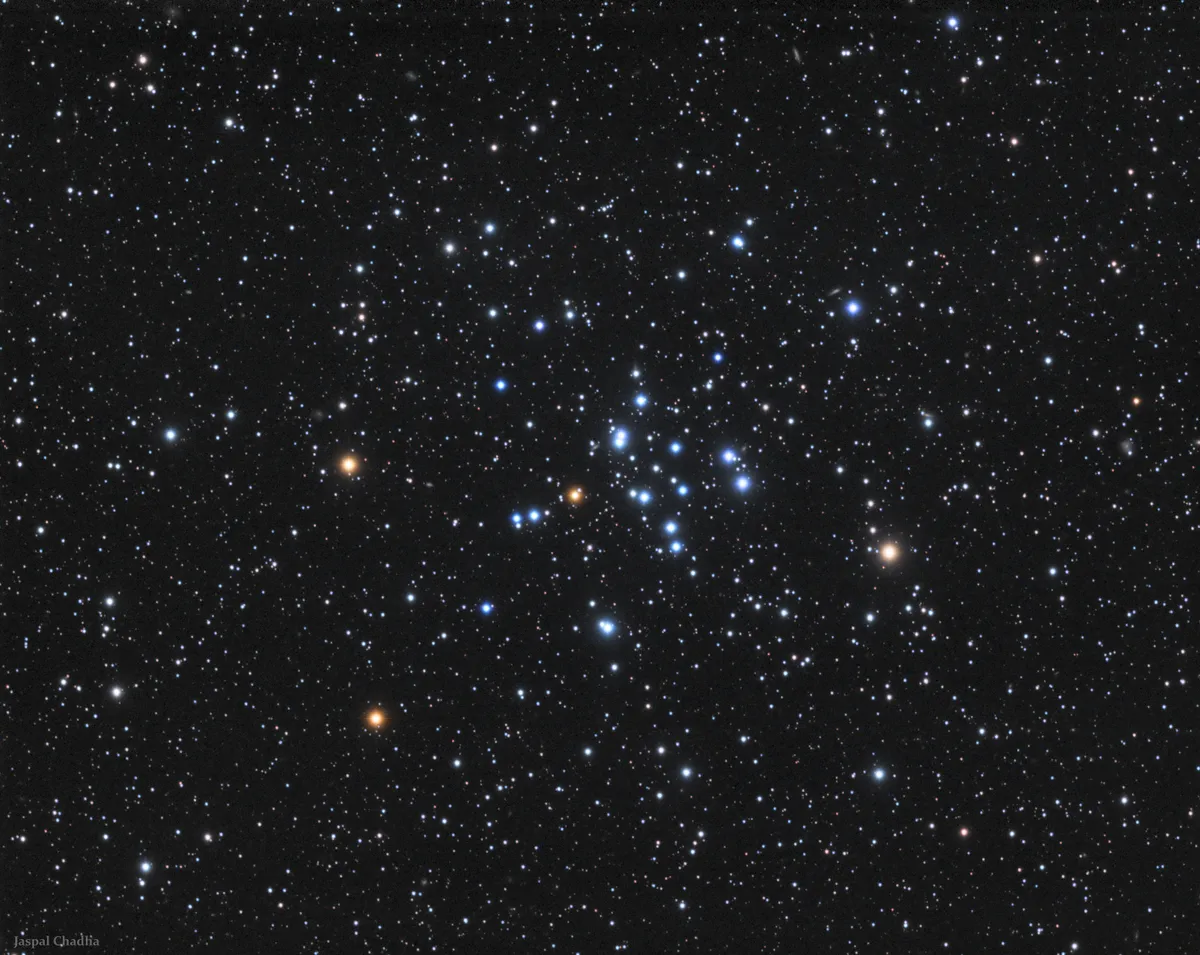
Download our September 2024 binocular tour form (PDF)
1 - Alpha Persei Moving Cluster
Melotte 20 extends nearly 4° southeast from mag. +1.8 Mirfak (Alpha (α) Persei), with its hot, young, blue and blue-white (spectral types O and B) stars sparkling like diamonds on black silk. The colour of the stars hints at the relative youth (60 million years old) of this stunningly beautiful cluster. It’s called ‘moving’ because all the stars share a similar proper motion (motion relative to the celestial sphere).
2 - Kemble’s Cascade
During late summer evenings, Kemble’s Cascade is approximately vertical in the sky, so you get the full effect of a ribbon waterfall falling into a splash pool (the open cluster NGC 1502). To find it, extend a line from mag. +2.3 Caph (Beta (β) Cassiopeiae) to mag. +3.3 Segin (Epsilon (ε) Cassiopeiae) the same distance to the mag. +5.0 star in the middle of a line of eighth and ninth-magnitude stars.
3 - The Queen’s Kite
Locate mag. + 4.7 Chi (χ) Cassiopeiae 1.5° to the south-east of mag. +2.7 Ruchbah (Delta (δ) Cassiopeiae). Continue another 0.75°, where you’ll find a mag. +7.3 star in the middle of a pentagon of stars of which Chi Cassiopeiae is the brightest. The 1.5°-long tail extends southward from the east of the pentagon. Note the colours of the stars: the two brighter stars are yellow, while all the fainter ones are brilliant white.
4 - M34
Use the chart to identify the yellow-white mag. +5.4 star 14 Persei and you should see this bright open cluster about 1.5° to the south; you are seeking a fuzzy patch about the same apparent size as the Moon. You should be able to resolve at least a dozen stars, the brightest of which form a distorted ‘H’ shape. You are looking at starlight that left this 220-million-year-old cluster some 1,400 years ago.
5 - NGC 752 and the Hockey Stick
Locate Beta (β) Trianguli, place it at the bottom of the field of view and NGC 752 should appear near the top, just to the left of a close pair of sixth-magnitude deep-yellow stars (56 Andromedae). Rising to the right you’ll see a straightish chain of sixth and seventh-magnitude stars, forming a hockey-stick-shaped asterism more than 1.5° long, with NGC 752 as a large fuzzy ball.
6 - The Andromeda Galaxy
Begin at the distinctly yellow mag. +2.0 Mirach (Beta (β) Andromedae) at one side of the field of view and white mag. +3.9 Mu (µ) Andromedae at the other. Place Mu where Mirach was, and the elliptical shape of M31, the Andromeda Galaxy, will appear where Mu was. Notice the bright glow of its nucleus and see if you can identify the companion galaxies M32 and M110.
6 binocular night-sky targets for August 2024

Download our August 2024 binocular tour form (PDF)
1 - Poniatowski’s Bull
The uppercase V formed by the fourth- and fifth-magnitude stars 66, 67, 68, 70 and 73 Ophiuchi is reminiscent of the Hyades cluster in Taurus. This led the 18th-century astronomer Marcin Odlanicki Poczobutt to propose it as a new constellation, Taurus Poniatovii, to honour Stanislaus Poniatowski, then king of Poland. Your binoculars will reveal many dozens more stars in this rich open cluster, more formally known as Melotte 186.
2 - The Summer Beehive
Locate mag. +2.7 Cebalrai (Beta (β) Ophiuchi) and you’ll see IC 4665 in the same field of view, looking like a slightly smaller version of Praesepe (the Beehive Cluster) just over 1° northeast of the star. Your 10x50s should reveal curved chains of white stars forming the word ‘HI’, as this lovely cluster literally welcomes you to this beautiful region of sky. How many more stars can you count?
3 - NGC 6633
From IC 4665, turn 10° east to NGC 6633. This lovely little cluster is often overlooked in lists of binocular objects because it can be tricky to find, but it’s easily visible in a pair of 10x50s, with the four brightest stars shining against the 20-arcminute elongated glow of the unresolved fainter cluster stars. If you compare it to the Summer Beehive, you will see that its stars are yellower, and therefore older.
4 - Graff’s Cluster
From NGC 6633, pan 3° in the direction of mag. +4.6 Alya (Theta (θ) Serpentis), where you will find a misty patch just over 1° in diameter. This is Graff’s Cluster, IC 4756. It’s an enormous grouping of stars, over 20 lightyears across and approximately 1,300 lightyears away. You can hold it and NGC 6633 in the same field of view, as a simple demonstration of how different similarly-aged clusters can appear.
5 - Barnard’s E
Find mag. +2.7 Tarazed (Gamma (γ) Aquilae) and look 1° west of it. Dark nebulae B142 and B143 are usually easy to identify because of the rich Milky Way starfield against which they lie. These accumulations of obscuring dust manifest as an uppercase ‘E’ or an underlined ‘C’, depending on sky transparency. If you can see only one sooty bar, you have the middle one; averted vision should reveal the others.
6 - The Coathanger, Al Sufi’s Cluster
In his AD 964 Book of Fixed Stars, Abd al-Rahman al-Sufi recorded the cluster that bears his name. It lies 5° south of mag. +4.4 Anser (Alpha (α) Vulpeculae). In this relatively dark part of the Milky Way there’s enough contrast for even quite small binoculars to reveal the 10 brightest stars whose pattern bestows its informal name, the Coathanger.
6 binocular night-sky targets for July 2024
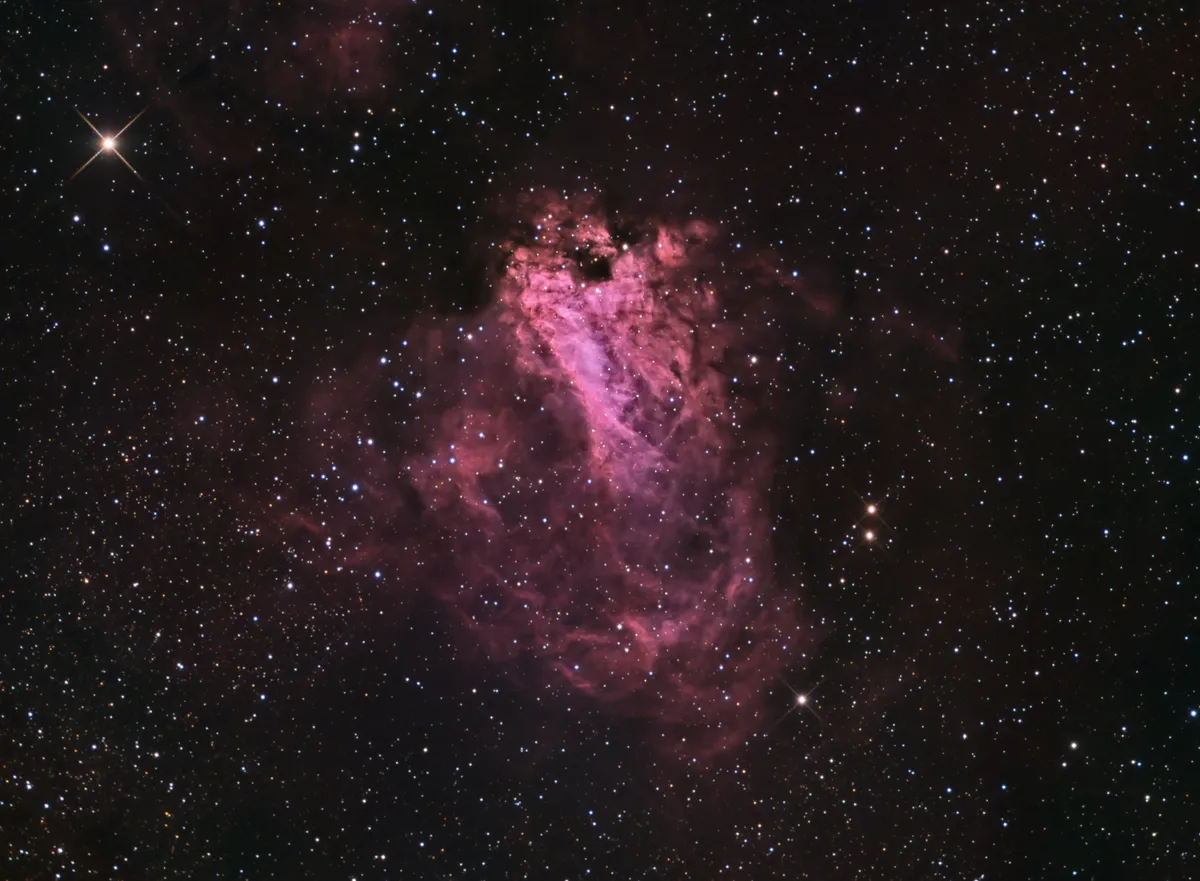
Download our July 2024 binocular tour form (PDF)
1 - The Scutum Star Cloud
This fabulously rich star cloud is so easy to find that it has been mistaken for a real cloud on a clear night. Once you have it in your binoculars, look for the ripples of stars formed by the tenuous dark nebulae that weave among them. You will also see the densest of all open clusters, M11, the Wild Duck Cluster, which is an even richer condensation of nearly 3,000 hot blue stars.
2 - The Swan Nebula, M17
Use the chart to help you identify Gamma (γ) Scuti, then pan 2.5° to the southwest where you will find the misty patch that Charles Messier described as “a train of light without stars, in the shape of a spindle, of five or six minutes in extent”. If you use averted vision, you may be able to make out a small hook-like extension extending south from the top right-hand side of the patch.
3 - M22
Next, the largest globular cluster visible from the UK. To find M22, put mag. +2.8 Kaus Borealis (Lambda (λ) Sagittarii), the top of the ‘lid’ of the Teapot asterism in Sagittarius, at the south-west of the field of view. M22 should be obvious near the centre. It shows a bright core, very much like a comet, making it clear why Charles Messier compiled his catalogue of objects that were not to be mistaken for comets.
4 - 52 and 53 Sagittarii
We’ll continue the tour with two easy line-of-sight (that is, not true binary) double stars. The first is a white pair, mag. +4.6 52 Sagittarii and mag +5.6 51 Sagittarii, which are 13 arcminutes apart. The 53 Sagittarii pair is fainter, closer and displays more of a colour contrast. 53 Sagittarii shines at mag.
+6.3, a third of a magnitude fainter than its orange companion, 4 arcminutes to the east.
5 - The Butterfly Cluster, M6
This lovely open cluster is visible to the naked eye in a clear sky, but we are using binoculars because it is very low in the southern sky, so you’ll need a pristine southern horizon if you are to see a hint of the wings and antennae that give it its common name. You’ll find it in a sparse patch of the Milky Way, around 6° west of mag. +3.0 Alnasl (Gamma2 (γ2) Sagittarii).
6 - Ceres
This apparition of asteroid Ceres is at its brightest (mag. +7.5) in early July, when you’ll find it 1.5° south of mag. +3.3 Tau (τ) Sagittarii. It fades by a little more than half a magnitude during the month as it moves 6° west into the lower part of Sagittarius’s Teapot. Ceres was discovered on the first day of 1801 at the Palermo Observatory and named for the patron goddess of Sicily.
6 binocular night-sky targets for June 2024
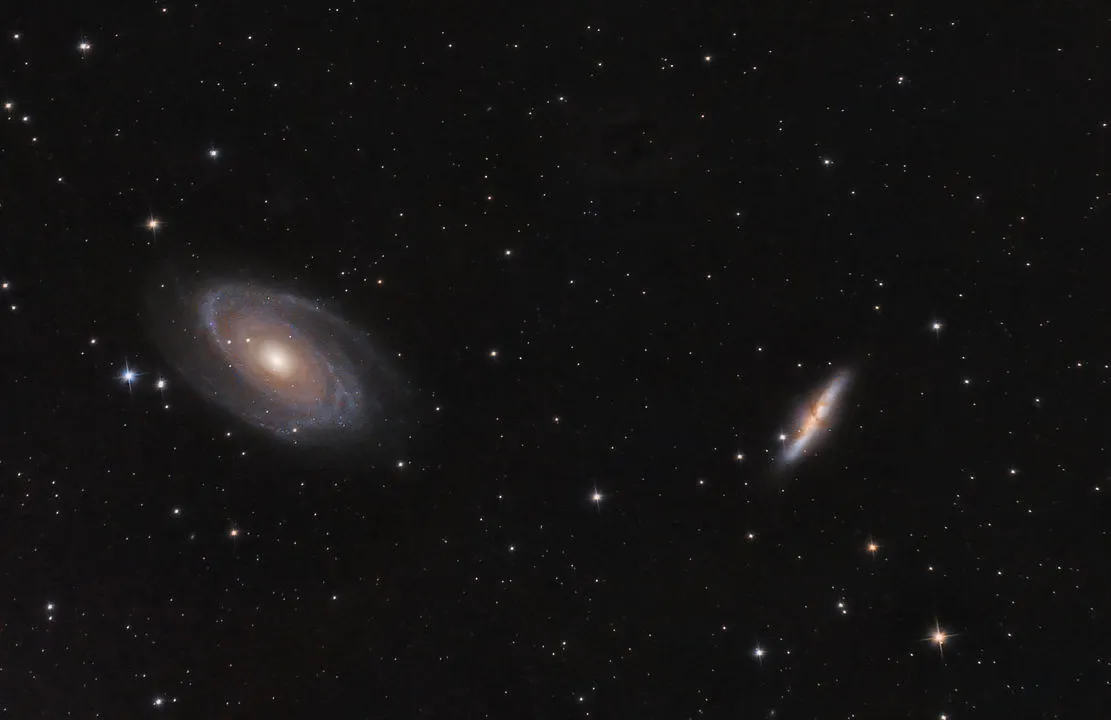
Download our June 2024 binocular tour form (PDF)
1 - M81/82 galaxy pair
This month we’ll tour the north polar region of the sky, starting with the galaxy pair M81 (Bode’s Galaxy) and M82 (the Cigar Galaxy). Use the chart to identify mag. +4.6 24 Ursae Majoris and you should be able to get the galaxies in the same field of view. You can use them to demonstrate averted vision: concentrate your gaze on one of them and the other will appear to brighten and grow.
2 - Kappa Dra group
We move on to a lovely little line of coloured stars. The brightest of these is the hot (14,000K) blue-white
mag. +3.9 Kappa (κ) Draconis, shining with a luminosity 500 times greater than the Sun. North of it you’ll see two orange stars, the brighter of which is mag. +4.9 6 Draconis. At the other end of this line of four you’ll find the reddish 4 Draconis, a long-period pulsating variable (mag. +4.9 to +5.0).
3 - Polaris ‘Engagement Ring’
Mag. + 2.0 Polaris (Alpha (α) Ursae Minoris) is a useful marker for the North Celestial Pole (NCP), but binoculars reveal that it’s not alone, but part of a circlet of mostly eighth- and ninth- magnitude stars, like a solitaire diamond in an engagement ring. One star in the circlet is slightly displaced away from Polaris, which bisects the line joining it and the NCP, enabling a precise determination of the pole’s location.
4 - The Guardians of the Pole
After Polaris, the next brightest stars in Ursa Minor are the southernmost stars of the Little Dipper: orange mag. +2.0 Kochab (Beta (β) Ursae Minoris) and brilliant-white mag. +3.0 Pherkad (Gamma (γ) Ursae Minoris). From our latitude, they’re circumpolar and have traditionally been called the Guardians of the Pole. Pherkad is an easy double, with fifth-magnitude pale orange Gamma1 (γ1) Ursae Minoris
17 arcminutes to the west.
5 - Kemble 2
Find mag. +3.6 Chi (χ) Draconis, then navigate 1° east where you’ll see a little equilateral triangle of seventh-magnitude stars. Look carefully to see a pair of fainter stars that complete a trapezium, of which the triangle is a part, forming a ‘W’ with the fainter stars at the tips. This similarity to the ‘W’ of Cassiopeia gives the group it’s common names, Mini-Cass or the Little Queen.
6 - The Iris Nebula
Take a line from mag. +3.2 Errai (Gamma (γ) Cephei) to the sapphire-blue mag. +3.2 Alfirk (Beta (β) Cephei) and extend it a further 3°, you will find a mag. +6.9 star. Half a degree west of this star is a mag. +7.4 star. Centre this star and use averted vision and patience. Surrounding the star, you should begin to notice the faint glow of NGC 7023, the Iris Nebula, a few arcminutes across.
6 binocular night-sky targets for May 2024
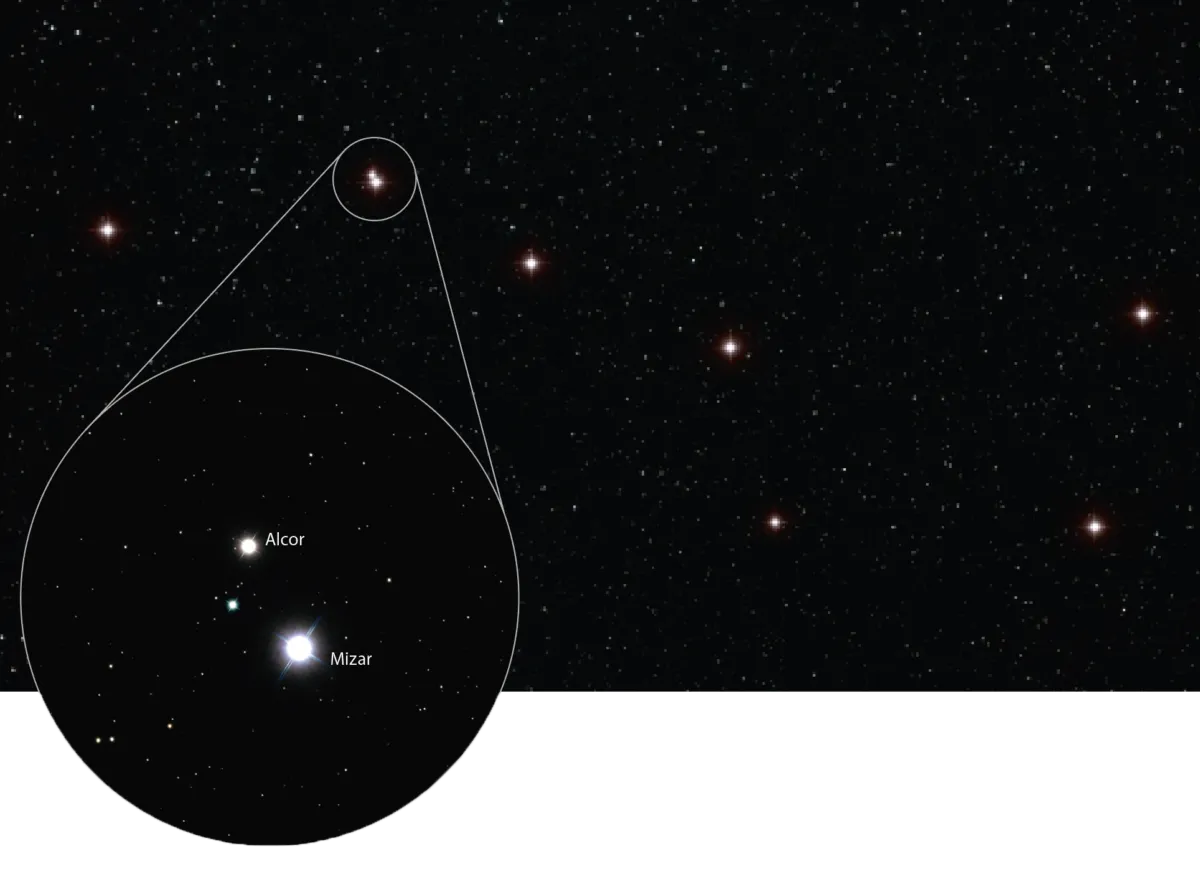
Download our May 2024 binocular tour form (PDF)
1 - Mizar and Alcor
In the days before Herman Snellen introduced his eponymous eye-test chart, mag. +2.2 Mizar (Zeta (ζ) Ursae Majoris) and mag. +4.0 Alcor (80 Ursae Majoris) were used as an eyesight test: if you couldn’t see two stars, you knew you needed spectacles.
They are, of course, easy to split in binoculars and these also reveal a fainter (mag. +7.6) companion that makes the southeast apex of a triangle with Alcor and Mizar.
2 - V Canum Venaticorum
Half-way between mag. +1.9 Alkaid (Eta (η) Ursae Majoris) and mag. +2.9 Cor Caroli (Alpha (α) Canum Venaticorum) lies a pair of sixth-magnitude stars about 0.25° apart.
From there, pan 1.5° towards 21 Canum Venaticorum where you should find, shining somewhere between mag. +8.5 and +6.5, V Canum Venaticorum. It’s often described as a periodic variable, but both its range and period have fluctuated wildly in recent years.
3 - La Superba
Locate mag. +4.2 Chara (Beta (β) Canum Venaticorum) and pan 4.5° towards Mizar to find a pale orange star (it looks a deeper orange in larger apertures). This is Y Canum Venaticorum, a cool carbon star whose magnitude varies from +6.3 to +4.7, with a period of about 160 days.
Its common name, La Superba, was given on account of its unusual spectrum, in which absorption lines attenuate much of the short wavelength light.
4 - 15 and 17 Canum Venaticorum
Navigate a little more than 2.5° east from Cor Caroli, where you’ll find a widely separated (4.6 arcminutes) pair of stars, mag. +6.3 15 and mag. +5.9 17 Canum Venaticorum. This is not a binary star, but merely a line-of-sight pairing that shows how distance affects magnitude: although 17 appears to us
as the brighter of the pair, 15 is six times as far and 25 times as bright as 17.
5 - M106
You’ll need a dark, transparent sky for this galaxy. Find the orange star mag. +5.3 3 Canum Venaticorum, which makes the right angle of a triangle with Chara and mag. +3.7 Chi (χ) Ursae Majoris. Slightly more than 1.5° south of this is a small, faint glow.
This is the 22-million-year-old light from the nucleus of M106. Try using averted vision to see it elongate from southeast to northwest.
6 - M51, the Whirlpool Galaxy
Our next galaxy is a bit brighter and is very easy to find. Imagine that a line from Mizar to Alkaid is the upright of a letter ‘L’. M51 lies at the ‘toe’ of this ‘L’, 3.5° from Alkaid.
You’ll see the glow of the 25 billion suns that comprise the Whirlpool Galaxy, 20 million lightyears away. Any elongation you see is due to NGC 5195, the smaller galaxy with which the main face-on spiral is interacting.
6 binocular night-sky targets for April 2024
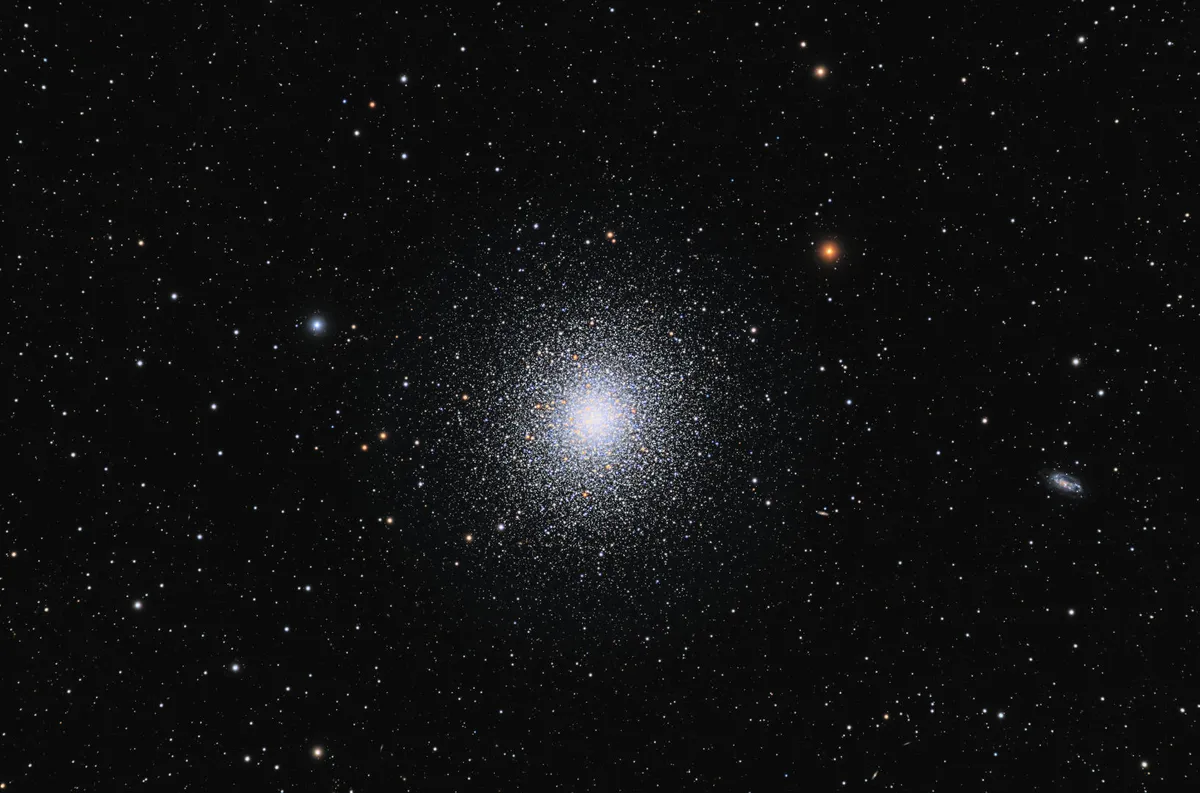
Download our April 2024 binocular tour form (PDF)
1 - M13, the Great Cluster in Hercules
As we approach the season for trying a Messier marathon, M13 reminds us why Charles Messier created his famous catalogue of objects not to be mistaken for comets, known as the Messier Catalogue.
The great Hercules globular cluster lies one-third of the way down the western side of the Keystone asterism. In binoculars, it looks just like a comet, brightening towards the core. You might even be able to see it with your naked eye in very transparent skies.
2 - Nu Coronae Borealis
Nu (ν) Coronae Borealis appears as a double to your naked eye and is therefore easily split in small binoculars. The stars of this optical double (a chance line-of-sight pairing of stars that are not gravitationally bound) are both giants of about 2.5 solar masses.
Although the brighter star, mag. +5.2 Nu1 (ν1), is more distant, it’s at a later stage of evolution and therefore more luminous than mag. +5.4 Nu2 (ν2).
3 - Tau Coronae Borealis group
Navigate 4° northwest from Nu (ν) Coronae Borealis to find mag. +4.7 Tau (τ) Coronae Borealis, the brightest star in a very pretty, straight chain of five stars running east–west for 2.6°.
All but the central star, a mag. +7.4 triple star resolvable in binoculars, shine brighter than magnitude +6, and binoculars reveal their colours. Notice that the mag. +5.6 stars at the ends of the chain are a deeper yellow than the others.
4 - R Coronae Borealis
Lying in the middle of the Northern Crown, R Coronae Borealis usually shines at mag. +5.9, but the brightness of this enigmatic variable star randomly plummets as low as mag. +15, like a reverse nova.
It does this very quickly, so it’s worth observing the star on every clear night. R Coronae Borealis periodically puffs out jets of carbon which, if they are in line of sight with us, obscure this ‘sooty’ carbon star.
5 - Delta Boötis
Mag. +3.5 Delta (δ) Boötis is a very easy double. The primary is a deep-yellow giant nearly 60 times more luminous than the Sun. Its mag. +7.8 companion, 105 arcseconds to the east, is slightly paler.
At 117 lightyears distance from us, that 105 arcseconds translates to an enormous 0.6 lightyears apart. At that separation, the orbital period of this binary system is about 120,000 years.
6 - RV Boötis
The reddish variable (mag. +7.2 to +8.7) star RV Boötis is a little more than 2.5° northeast of mag. +3.6 Rho (ρ) Boötis, in between two mag +6.3 stars, the brightest in the field of view.
RV Boötis is a semi-regular variable with a period of 288 days. The Sun will eventually become like RV Boötis, with an inert core surrounded by helium- and hydrogen-burning shells within a hydrogen envelope.
6 binocular night-sky targets for March 2024

Download our March 2024 binocular tour form (PDF)
1 - Melotte 111
We’ll start with a favourite ‘made for binoculars’ target. Look midway between mag. +2.9 Cor Caroli (Alpha (α) Canum Venaticorum) and mag. +2.1 Denebola (Beta (β) Leonis) and you should see a misty patch about 6° across.
Your 10x50s will resolve it into 30 or more stars, all of which are mag. +10.5 or brighter; any fainter ones have been gravitationally ejected from the cluster by a process called mass segregation.
2 - M53
A degree northeast of mag. +4.9 Diadem (Alpha (α) Comae Berenices), there’s a small misty patch that appears to grow in size and brightness if you centre it in the field of view but look at Diadem.
This is the globular cluster M53, and the trick you used to make it grow is averted vision, which puts the light from the object onto a more sensitive part of your retina. We’ll use it later for galaxy hunting.
3 - M3
Our next target is one of the finest globular clusters in the northern sky, but there are no nearby bright stars to help you find it. However, if you look half-way between mag. –0.1 Arcturus (Alpha (α) Boötis) and Cor Caroli, you should find what looks like an out-of-focus star.
Use averted vision and you will see more of the glow of the nearly half-million stars that comprise M3, discovered by Charles Messier in 1764.
4 - M94
Return to Cor Caroli and imagine a line between it and mag. +4.2 Chara (Beta (β) Canum Venaticorum). From half-way along this line, navigate 1.6° to the northeast. Here, possibly needing averted vision at first, you should find the 13.6-million-year-old glow of light from the spiral galaxy M94.
Like all galaxies, it benefits greatly from dark, transparent skies, but it is usually quite easy to see even in suburban skies.
5 - M49
Locate mag. +4.9 Rho (ρ) Virginis and place it on the northeast of your field of view. On the opposite side you’ll see two sixth-magnitude stars, just over a degree apart and orientated southeast–northwest.
The 37-million-year-old fossil light from M49 is the small, oval patch between them. Using averted vision, see how many more galaxies you can find between M49 and Melotte 111.
6 - 86 Leonis star field
Let’s finish with a colourful star field. Locate the orange-yellow mag +5.6 86 Leonis between Denebola and mag. +2.6 Zosma (Delta (δ) Leonis); compare it to brilliant-white mag. +6.3 90 Leonis, 2° back towards Denebola.
Find the curved string of multicoloured seventh and eighth-magnitude stars that extends 3° eastward from 86 Leo. Scan northeast of here too, if you like colourful stars.
6 binocular night-sky targets for February 2024
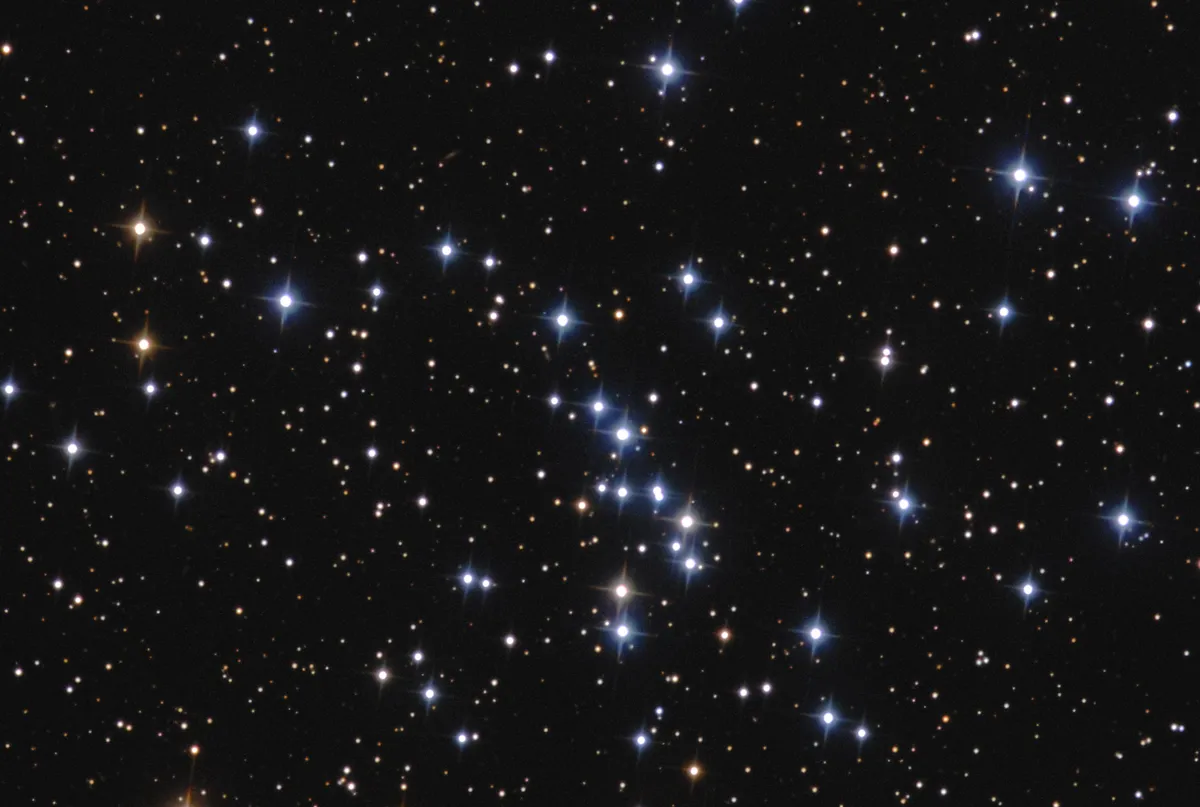
Download our February 2024 binocular tour form (PDF)
1 - The Hydra’s Head
The one immortal head of the Hydra, the longest constellation, is defined by six stars, its brightest being Alphard. But only the faintest, mag. +4.4 Sigma (σ) Hydrae, retains a name – Minchir (the nostril) – that relates to Heracles’s nine-headed nemesis.
Binoculars enable you to enjoy the wide variation in colours, from the intense white of mag. +4.3 Eta (η) Hydrae to the yellow-orange of mag. +3.1 Zeta (ζ), the brightest of the six.
2 - The Missing Messier, M48
It was 12 years after Charles Messier incorrectly catalogued the position of M48 that Caroline Herschel rediscovered it, but it took over a century and a half for astronomers to realise she’d found the object that matched Messier’s description.
Find this open cluster 3° southeast of mag. +4.4 Zeta (ζ) Monocerotis, as a condensed patch of stars of which you can resolve a few brighter members against a rich background glow.
3 - M50
Use the chart at the link above to locate M50, an obvious circular glow about half the apparent diameter of the Moon. This 78-million-year-old cluster lies 3,200 lightyears away and measures about 20 lightyears across.
The glow comes from a little more than 100 stars, but don’t expect to resolve more than four or five of them in 10x50 binoculars, the number depending on the darkness and transparency of your sky.
4 - 14 CMi
Mag. +5.3 14 Canis Minoris is the middle star in a slightly curved line of three in the southeast of Canis Minor. This deserves a closer look, ideally using larger binoculars, which will show you that it’s actually a triple star, with two very much fainter companions.
The brighter one (mag. +9.4) lies 102 arcseconds to the east, and the other (mag. +9.8) is 137 arcseconds to the southeast of 14 CMi.
5 - The Beehive Cluster (M44) and the Manger
Named by the ancient Greeks as Nephelion, the Little Cloud, M44 is an ideal object for binoculars. It is framed by an asterism of four bright stars known as Praesepe (the Manger), and is visible to the naked eye as a misty patch just north-northeast of mag. +3.9 Asellus Australis (Delta (δ) Cancri).
It is one of the nearest open clusters and contains over 1,000 stars.
6 - Iota Cancri
You should be able to identify this month’s tricky target, mag. +4.0 double star Iota (ι) Cancri, with your naked eye. Its primary member is a yellow giant and its secondary is a mag. +6.0 white dwarf, 30 arcseconds to the northwest.
The magnification of 15x70s will help you split this true binary star, which has an orbital period of 65,000 years.
6 binocular night-sky targets for January 2024
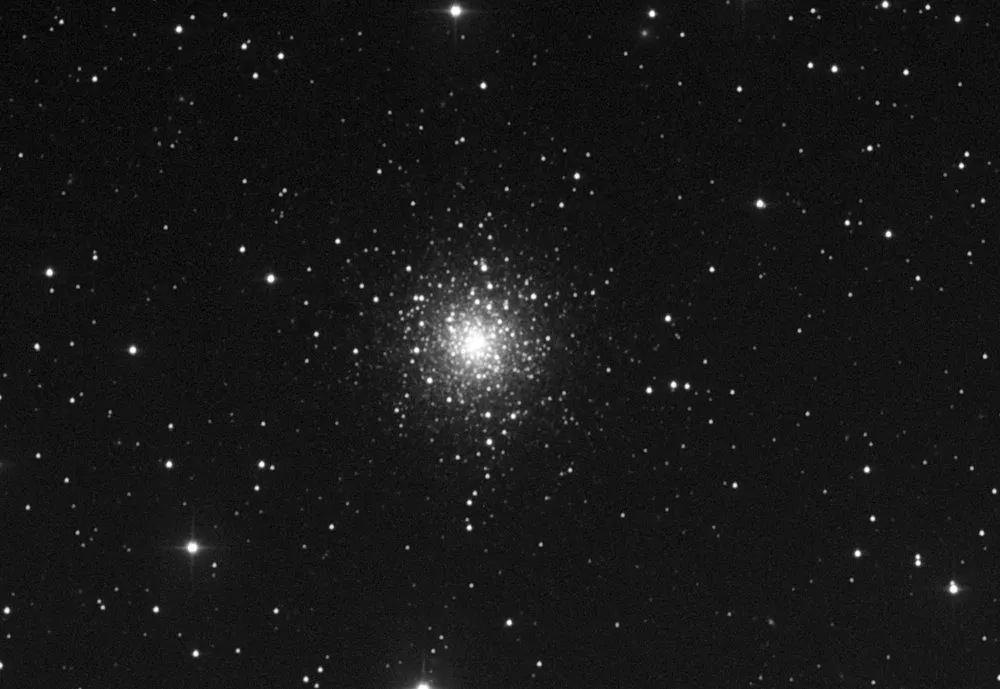
Download our January 2024 binocular tour form (PDF)
1 - The Stream
Let’s start the tour 6° to the west of mag. +3.3Mu (µ) Leporis, where you’ll find the orange mag. +5.0 60 Eridani at the north of a 4.5° chain of stars.
Follow the chain through yellow 59 and 58 Eridani, via a white star, to the reddish mag. +4.3 54 Eridani, the brightest star in the group. On a transparent night, see how many fainter stars you can see, especially near the top of the chain.
2 - Iota and RX Leporis
Nearly 4° south of mag. +0.3 Rigel (Beta (β) Orionis) lies mag. +4.5 Iota (ι) Leporis, a brilliant-white star that contrasts beautifully with the fainter reddish star RX Leporis that lies 0.25° to the west of it.
RX Leporis is slightly variable, oscillating between magnitudes +5.1 and +6.7 over a period of 79.5 days, but this main period is overlaid by longer periods and it is classified as an ‘unsolved’ semi-regular variable.
3 - Zibal
The pure-white mag. +4.8 Zibal (Zeta (ζ) Eridani) should be just visible to your naked eye if your southern aspect is good. It’s part of a wide pair, the other member being mag. +6.1 14 Eridani (mag. +6.1), 0.5° to the south-east.
Close examination will reveal another companion northwest of Zibal, a mere 5 arcminutes away, shining at mag. +6.6. Both of these companions are line-of-sight associations.
4 - 62 Eridani
Use the chart to identify mag. +2.7 Cursa (Beta (β) Eridani). Linger for a while, taking time to appreciate its rich and colourful stellar environment, before heading 3° due west to the brilliant blue-white magnitude +5.5 62 Eridani.
This can be a tricky double star, not because of the separation, which is a substantial 66 arcseconds, but because the line of sight companion is so much fainter (mag. +8.9) than 62 Eridani.
5 - CV Eridani
In the northwest corner of Eridanus lies a little triangle of stars that covers about the same amount of sky as the Moon. The most easterly of these is mag. +6.1 7 Eridani, also designated CV Eridani.
‘CV’ indicates that it’s a variable star, but the reason for its inclusion here is the beautiful contrast of its redness against the whiteness of the other two stars in the triangle.
6 - M79
Identify mag. +2.6 Arneb (Alpha (α) Leporis) and mag. +2.8 Nihal (Beta (β) Leporis) and mag. +3.6 Gamma (γ) Leporis. Extend a line from Arneb to Nihal southwards for just over 4°, where you will find a mag. +5.4 star.
Without looking away from this star, turn your attention to a spot about 0.5° away in the direction of Gamma. What looks like a faint fuzzy star is the globular cluster M79.
6 binocular night-sky targets for December 2023

Download our December 2023 binocular tour form (PDF)
1 - The Hyades
The Hyades cluster is next to mag. +1.0 Aldebaran (Alpha (α) Tauri), the reddish eye of the Bull, which is not part of the cluster but a foreground star. The cluster is only 153 lightyears away, making it the nearest open cluster to us.
In mythology, the Hyades were the daughters of Atlas, and their weeping for their brother Hyas, who was slain by a lion, is the rain that is associated with their heliacal setting in spring.
2 - NGC 1647
About 3° northeast of Aldebaran is a lovely little cluster, NGC 1647, often ignored because of the presence of its more prominent neighbour.
With 10x50s you should be able to see eight or nine stars against a background glow about one and a half times the apparent size of the Moon. It’s actually twice the size of the Hyades, but nearly 12 times the distance, which is why it seems so small
in comparison.
3 - NGC 1662
Switch to larger binoculars for our next target, 6.25° from Aldebaran in the direction of mag. +0.3 Rigel (Beta (β) Orionis). In 15x70 binoculars, NGC 1662 appears as a complex winding string of stars against an elliptical background glow.
With a core of about 10 lightyears diameter, it’s approximately the same size as the Hyades, but is nearly 10 times as far away.
4 - Collinder 70
Most amateur astronomers have seen Collinder 70 without realising it: it’s the oval-shaped group of very young bluish-white stars that surrounds the Belt stars of Orion.
On a clear night, you should be able to see at least 70 stars in this magnificent cluster. They form some beautiful curved chains, in particular the S-shaped chain that weaves its way between mag. +1.8 Alnilam (Epsilon (ε) Orionis) and mag. +2.4 Mintaka (Delta (δ) Orionis).
5 - The Great Nebula in Orion
The Orion Nebula, M42, is a highlight of the winter skies and a superb object in binoculars of any size. It’s the nearest stellar nursery to Earth and is visible to the naked eye as the fuzzy central ‘star’ of Orion’s Sword.
It is extremely sensitive to sky transparency and is best observed soon after rain has cleaned the sky of dust, revealing its exquisite, intricate detail.
6 - M78
This demands mounted binoculars, a very transparent sky and averted vision. Put mag. +1.9 Alnitak (Zeta (ζ) Orionis) just outside the south-southwest of the field of view and a small misty glow should appear near the centre.
Brighter at the top than at the bottom, it looks like a comet, showing why Charles Messier put it in his catalogue of objects for comet-hunters to ignore, known as the Messier Catalogue.
6 binocular night-sky targets for November 2023
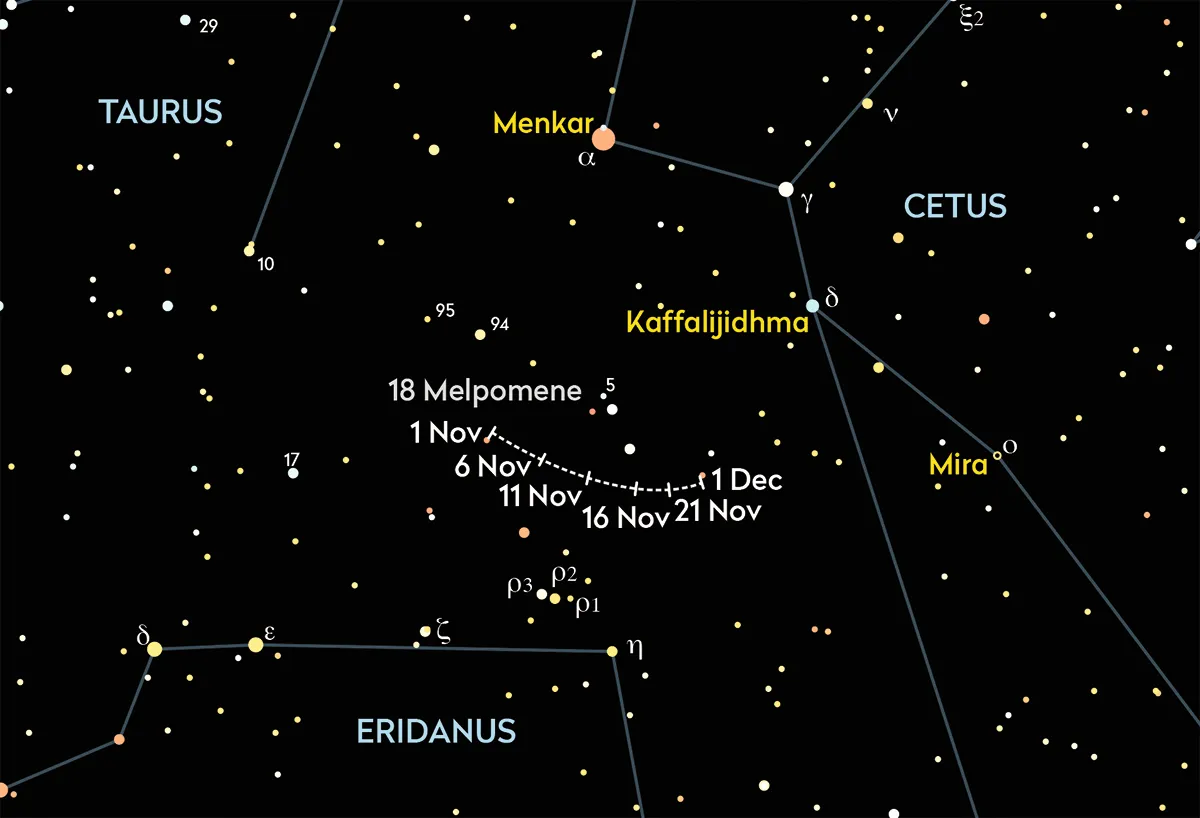
Download our November 2023 binocular tour form (PDF)
The Cosmic Question Mark
Use the chart at the link above to identify mag. +4.9 Nu (ν) Ceti and hold it at the bottom half of the field of view. You’ll see that it is the dot at the bottom of the 2.25°-long question mark asterism (an informal group of stars).
This is a good star-party object, both because of its shape and the colours of the fainter stars that make up the rest of the asterism.
The Pisces Parallelogram
If you follow a line up from mag. +2.0 Deneb Kaitos (Beta (β) Ceti; also known as Diphda) through mag. +3.5 Iota (ι) Ceti, you will find four stars of fifth magnitude (or so) that form a 3° x 1° parallelogram.
The northeast corner is blue-white 29 Psc, and diagonally opposite is orange 30 Psc; the other two corners of the parallelogram appear yellowish. See how the parallelogram appears empty: it contains only one star brighter than eighth magnitude.
T Ceti
Return to Deneb Kaitos and find the mag. +4.4 star 7 Ceti, 7° to the west. From there, go 2° to the southeast to T Ceti, the most westerly star in an equilateral triangle of sixth(ish)-magnitude stars, with a side of 1.5°.
T Ceti is a semi-regular variable star (mag. +5.0 to +6.9) with a period of 159.3 days. If you observe it every couple of weeks you should be able to notice this variation.
37 Ceti
The double star 37 Ceti lies nearly 2.5° west of mag. +3.6 Theta (θ) Ceti. Its components are 49 arcseconds apart, which theoretically should be an easy split, even with lower magnifications.
But the magnitude of the companion is only +7.9, which is 13 times less bright and can make splitting it a bit of a challenge. This is an optical double (a chance line-of-sight pairing), not a true binary star.
The Silver Coin Galaxy and NGC 288
With a good clear southern horizon, find the right-angled triangle of fifth-magnitude stars 5° south of Deneb Kaitos. Look below it for a rhombus of fainter stars. You’ll see the Silver Coin Galaxy (NGC 253) as an elongated glow about 1° beneath the rhombus.
Next look slightly less than 2° in the direction of Alpha (α) Sculptoris, where you should see the faint glow of the globular cluster NGC 288.
Melpomene
Asteroid 18 Melpomene has a very elliptical orbit with a period of 3.48 years, so approximately every seven years, when it’s near its perihelion, it appears brighter than usual.
It’s at peak brightness (mag. +8.2) at the beginning of November. To identify it, observe its environs over several nights to determine which ‘star’ moves relative to the others.
6 binocular night-sky targets for October 2023
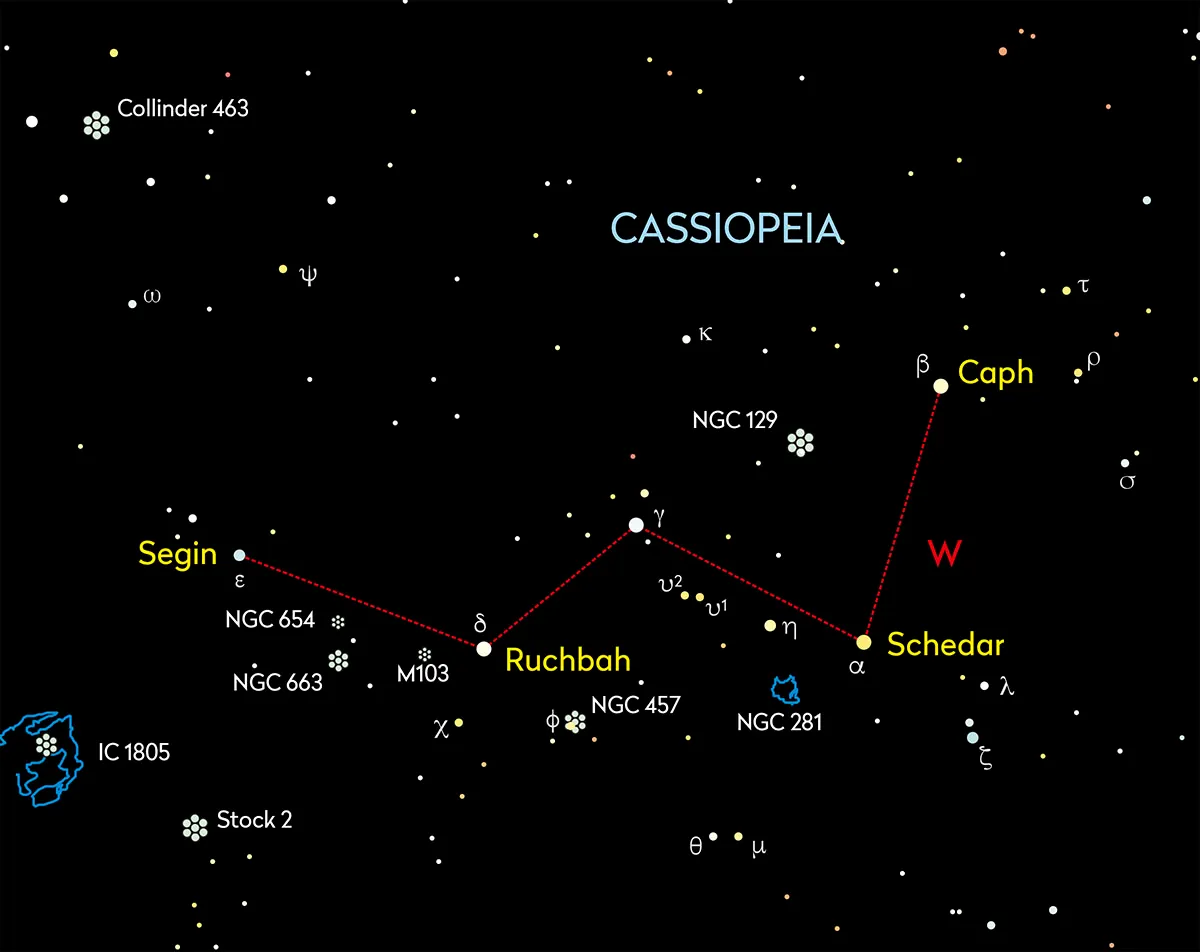
Download our October 2023 binocular tour form (PDF)
This month's targets are all located in and around the constellation Cassiopeia.
Kurhah star field
The very white mag. +4.4 Kurhah (Xi (ξ) Cephei) is the most northerly and brightest star of a lovely group that stretches southward for about 3°. There are some very red stars like mag. +5.2 18 Cephei and, at the other extreme, hot blue mag. +5.1 19 Cephei.
Give yourself time to appreciate the sheer variety of what’s on show and look around for the other, fainter groups of colourful stars that lurk nearby.
U Cephei
Eclipsing variable star U Cephei lies midway between two white mag. +5.6 stars, 7.5° from mag. +2.0 Polaris (Alpha (α) Ursae Minoris), the North Star, in the direction of mag. +2.1 Gamma (γ) Cassiopeiae.
Its magnitude range is +6.8 to +9.2, a nine-fold variation in brightness over a period of 2.5 days which, coupled with it being circumpolar from the UK, makes it a suitable subject for newcomers to variable star observing.
35 Cassiopeiae
If you imagine that Segin (Epsilon (ε) Cassiopeiae) and Ruchbah (Delta (δ) Cassiopeiae) and Gamma (γ) Cassiopeiae are the apexes of a rhombus, you’ll see a triangle of stars near the fourth apex.
The one nearest to Segin is mag. +6.3 35 Cassiopeiae, a very white star, but can you detect any colour in its mag. +8.4 companion 1 arcminute to the north? This is a line-of-sight pairing, not a true binary star.
Cassiopeia triple cluster (NGC 654, 659, 663)
Look 1° to the east of the middle of an imaginary line joining Segin and Ruchbah and you’ll easily find the largest and richest of these clusters, NGC 663. Slightly less than 1° to the north-northwest is the brighter but smaller NGC 654.
The poorest of the trio is NGC 659, a tiny ghostly glow which may need averted vision, just on the NGC 663 side of mag. +5.8 44 Cassiopeiae.
The Owl Cluster, NGC 457
Start at Ruchbah and navigate 2° southwest to mag. +5.0 (Phi (φ) Cassiopeiae) and its mag. +7.0 companion 2 arcminutes further on. These are the owl’s eyes.
The Owl Cluster's body and wings are ninth and 10th-magnitude stars that span an area about 0.25° in the direction of Gamma Cassiopeiae. The brighter eye is not actually part of NGC 457; it lies half-way between us and the 8,000-lightyear-distant cluster.
The Muscleman Cluster
Identify the Perseus Double Cluster (NGC 884 and NGC 869) and from the part nearest to Cassiopeia follow a 2° chain of eighth-magnitude stars north to Stock 2, the Muscleman Cluster.
This gets its name from the brighter stars having the form of a stick-man in muscle-flexing body-builder pose, ripping this star-chain away from the Double Cluster.
6 binocular night-sky targets for September 2023
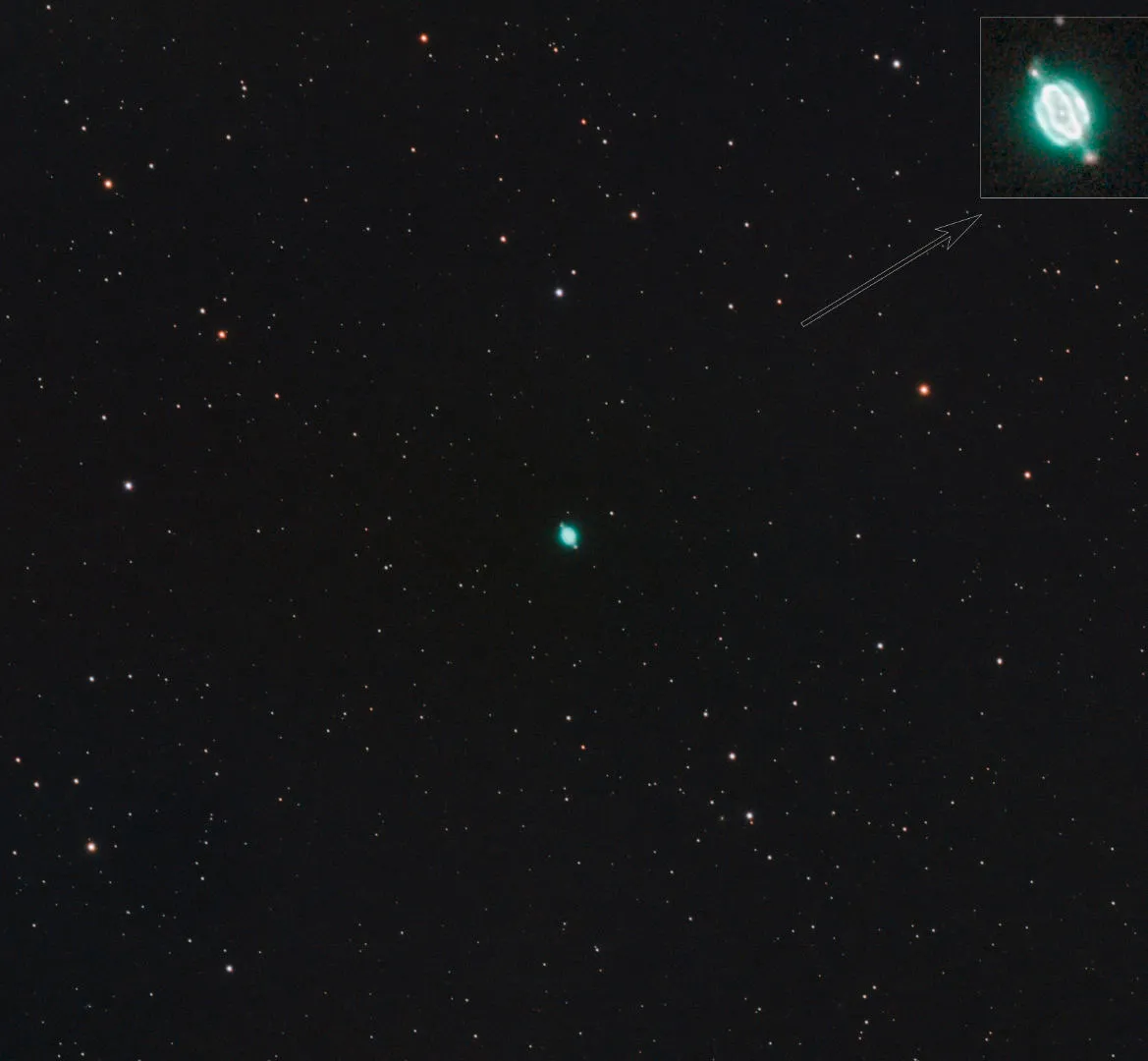
Download our September 2023 binocular tour form (PDF)
M2
Charles Messier described the globular cluster M2 as “a nebula without stars”. You’ll find it due north of Sadalsuud (Beta (β) Aquarii) and due west of Sadalmelik (Alpha (α) Aquarii).
It’s obvious in a star-sparse region of sky; even in small binoculars you should be able to see this 38,000-lightyear-distant glow. If you use averted vision, it will appear to grow slightly and may appear very slightly oval in shape.
Σ2809
From M2, head slightly more than a degree east-northeast to a mag. +6.2 star. This is the brighter component of a double-star system, Struve 2809.
Seeing the fainter companion is a good test of both 10x50 binoculars and your observing technique, because it’s a mere 31 arcseconds to the south-southeast and shines at only mag. +9.3. Don’t expect to see it consistently; it may ‘fade’ in and out of visibility.
Saturn and Titan
Saturn is the brightest object in the area covered by the chart, so is easy to locate. You won’t see the rings in 10x50 binoculars, but you can see the brightest moon, Titan, which shines at mag. +8.4.
Its period of orbit around Saturn is nearly 16 days and its angular distance from the planet ranges between 0.5 and 3 arcminutes, so the second-largest moon in the Solar System is quite easy to spot. ο
The Saturn Nebula, NGC 7009
If you want a good binocular observing challenge in British skies, this is a top candidate. Fortunately,
it’s very easy to locate, 1.3° due west of mag. +4.5 Nu (ν) Aquarii.
It appears as a slightly defocused star but, because it’s only about 0.4 arcminutes across, at this magnification you’ll not be able to see the elongation that Lord Rosse detected when he gave it its common name.
8 Flora
Here’s a rare opportunity to spot asteroid 8 Flora in binoculars. It starts the month at mag. +8.5, 6.7° south of Saturn and fades by a bit more than half a magnitude as it tracks 5° west-southwest during the month. It will be hard to identify against the background stars, so you’ll need to observe on several occasions to detect which of these ‘stars’ moves in relation to the others.
6. M30
If you plan to do a Messier Marathon (observing all 110 Messier objects between dusk and dawn) next spring, M30 is one you need to be confident of finding, being the difficult last object in a lightening dawn twilight sky. Autumn evenings are a very good time to start this practice. You’ll find it half a degree from mag. +5.2 41 Capricorni in the direction of mag. +3.7 Zeta (ζ) Capricorni.
6 binocular night-sky targets for August 2023
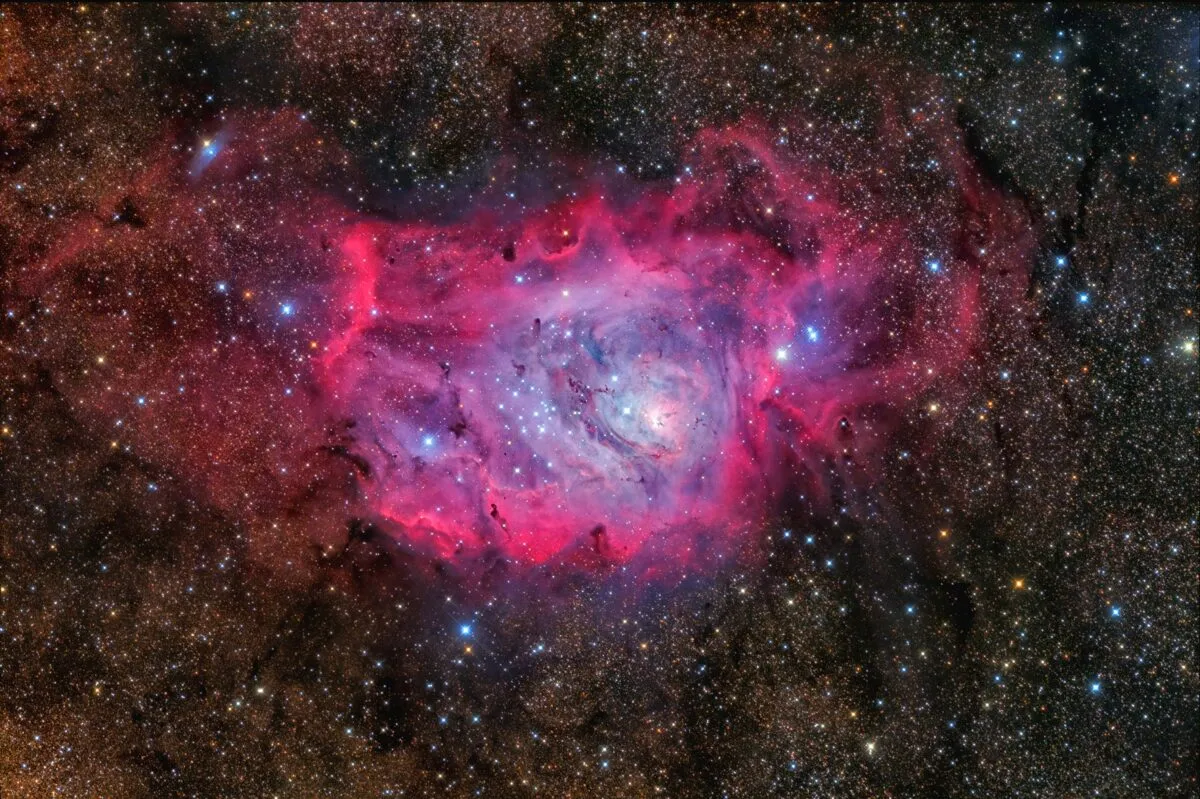
- Download our August 2023 binocular tour form (PDF)
M11, the Wild Duck Cluster
Our tour of the southern portion of the Milky Way begins with one of the densest open clusters, M11, the Wild Duck Cluster. You’ll find it 2° southeast of mag. +4.2 Beta (β) Scuti, spanning about 0.25° of sky.
In 10x50 binoculars, the cluster appears as a bright, slightly wedge-shaped glow. Were it not so rich, you may have had trouble identifying it against the Scutum Star Cloud, the densest part of the Milky Way.
M26
If you put mag. +3.8 Alpha (α) Scuti at the northwest of your field of view, open cluster M26, also known as NGC 6694, will be southeast of centre. Although it is only mag. +8.0, M26 is easy to find.
Look for a glowing kite shape which has the unusual feature of being less bright in the middle, due to some intervening interstellar dust, so what you see is an open cluster with a tiny dark nebula in the middle.
M24, the Sagittarius Star Cloud
M24 lies slightly more than half-way from mag. +4.7 Gamma (γ) Scuti to mag. +3.8 Polis (Mu (µ) Sagittarii). It is a bright patch of light that is easily visible to the naked eye and which has even been mistaken for a cloud just above the horizon.
It is a remarkably good object in 10x50 binoculars, in which nearly 1,000 stars are resolved in a single field of view!
M25 and U Sagittarii
If you navigate 4.5° south from Gamma Scuti, you should easily find the bright (mag. +4.6) open cluster M25, showing distinctly against the background Milky Way, with eight or so stars resolved against a grainy background.
It’s easier to distinguish the cluster from the background Milky Way in small binoculars than in large ones. The brightest star in the cluster is the Cepheid variable, U Sagittarii (which varies from mag. +7.2 to +6.5).
M23
M23 is just over half-way from mag. +3.5 Xi (ξ) Serpentis to Polis, but may be difficult to distinguish from the rich background of the Milky Way.
This bright, oval (15x27 arcminutes) open cluster is lovely in 70mm binoculars, which reveal about a dozen stars in the shape of a lower-case letter alpha (α) against the background glow of another 140 fainter stars.
M8, the Lagoon Nebula
Look for M8, the Lagoon Nebula, 6° west-northwest of mag. +3.0 Kaus Borealis (Lambda (λ) Sagittarii). It is visible to the naked eye if it’s high in a reasonably dark and transparent sky.
With 10x50s you’ll resolve more than half a dozen stars and reveal some of the surrounding nebulosity (NGC 6523) they illuminate, as well as the denser cluster of stars to the east of the main nebulosity.
6 binocular night-sky targets for July 2023

- Download our July 2023 binocular tour form (PDF)
1 - Sadr, the Heart of Cygnus
The mag. +2.2 star Sadr (Gamma (γ) Cygni) is sometimes called ‘the heart of Cygnus’, but it is really only part of the story. If you look carefully, you’ll notice that Sadr is merely the point of inflexion in a cardioid-shaped asterism of 11 mostly 6th-magnitude stars.
It has a diameter of a little less than 2° and offers a wide variety of colours, from deep orange through yellow and white, to an intense blue-white.
2 - NGC 6940
The open star cluster NGC 6940 deserves to be far better known. Use the chart to identify mag. +4.0 41 Cygni and mag. +4.9 30 Vulpeculae and you’ll find NGC 6940 between them, appearing like an oval patch of light that extends to the same apparent diameter as the Moon.
As you study the 2,700-year-old glow, you should be able to resolve eight or so stars of this very pretty cluster, depending on your sky conditions.
3 - The Dumbbell Nebula, M27
Our next stop is the easiest planetary nebula for binoculars, visible even in moderately light-polluted skies. If you place Gamma (γ) Sagittae at the south of a 5° field of view, the mag. +7.4 Dumbbell Nebula will be just north of centre, looking like a tiny luminous cloud.
Initially it will appear rectangular, but with patience you should make out the narrowing in the middle that gives it its common name.
4 - Barnard’s E Nebula
In a dark, transparent sky, this pair of dark nebulae, B142 and B143, which you will find 1° west of mag. +2.7 Tarazed (Gamma (γ) Aquilae) is easy to identify because of the rich Milky Way starfield against which it lies.
These agglomerations of obscuring gas and dust will appear to you as an uppercase ‘E’ or an underlined ‘C’, depending on sky clarity. The easiest bit to see is the middle bar of the E.
5 - Eta Aquilae
What was the first Cepheid variable star to be discovered? Answer: Eta (η) Aquilae (mag. +3.5 to +4.4) – not Delta (δ) Cephei, the star that gave its name to this class of variables.
Edward Piggott found variability in the former a month before John Goodricke found it in the latter. In 1912, Henrietta Leavitt discovered their period-luminosity relationship – the ‘standard candles’ Edwin Hubble then used to measure galactic distances.
6 - M15
Easy globular cluster M15 is one 15x70 field of view northeast of Delta (δ) Equulei. Don’t expect it to look even half as wide (18 arcminutes) as the published data suggests.
Most of its stars are in a core so dense that even the Hubble Space Telescope can’t resolve it, and only the central 7 arcminutes is visible in 70mm binoculars.
6 binocular night-sky targets for June 2023

- Download our June 2023 binocular tour form (PDF)
1 - M5
Let’s start with a fine globular cluster, M5, immediately north-northeast of mag. +5.0 5 Serpentis. It contains mostly Population II stars, which are among the oldest stars that we can see.
They are thought to be more than 12 billion years old, which suggests that they formed very soon after our Galaxy did. In 10x50 binoculars, you should notice that M5 brightens towards the centre, exactly like a comet does.
2 - Zubenelgenubi
In antiquity, the stars of Libra, the only non-living zodiac constellation, represented the claws of Scorpius, and the common name of mag. +2.7 Alpha (α) Librae, Zubenelgenubi, means ‘southern claw’ (the northern claw is mag. +2.6 Zubenelschamali (Beta (β) Librae).
Zubenelgenubi is a nice easy binocular double star. Binoculars easily reveal the mag. +5.2 companion 3.5 arcminutes away.
3 - Delta Librae
You’ll find the variable (mag. +5.8 to mag. +4.4) Delta (δ) Librae 8° north of Zubenelgenubi. It’s an eclipsing binary star (a pair of stars orbiting their common centre of mass) in which the drop in brightness, which lasts for about six hours, occurs as the dimmer star occults the brighter one.
The orbital period is 2.3 days, so even during short summer nights you’ll have several opportunities to notice the magnitude change.
4 - Xi1/Xi2 and 17/18 Librae
Midway between Delta Librae and Zubenelgenubi lie two optical double stars (not gravitationally bound binaries). Mag. +5.8 Xi1 (ξ1) and mag. +5.4 Xi2 (ξ2) Librae are separated by 0.75°.
Half a degree northeast of Xi2 is the other pair, mag. +6.6 17 Librae and mag. +5.8 18 Librae, which are nearly 10 arcminutes apart. There is about 50 lightyears between 17 and 18, and more than four times that between Xi1 and Xi2.
5 - M4
M4 is nearly 1.5° west of bright orange mag. +1.0 Antares (Alpha (α) Scorpii). It is only 7,000 lightyears away, making it appear rather loose, and is one of the few globular clusters in which you may be able to discern some structure with 15x70 binoculars.
M4 lies on the edge of the Milky Way, within a beautifully rich, colourful star-field that is more pleasing in binoculars than in a scope.
6 - Rho Ophiuchi
If you navigate 3° north from M4, you’ll find mag. +5.0 Rho (ρ) Ophiuchi. It is the bright component of a triple star, whose seventh-magnitude companions are 2.5 arcminutes to the north and west, respectively.
If you have an exceptional southern horizon sky and fancy a challenge, see if averted vision enables you to detect a slight brightening surrounding the star.
6 binocular night-sky targets for May 2023
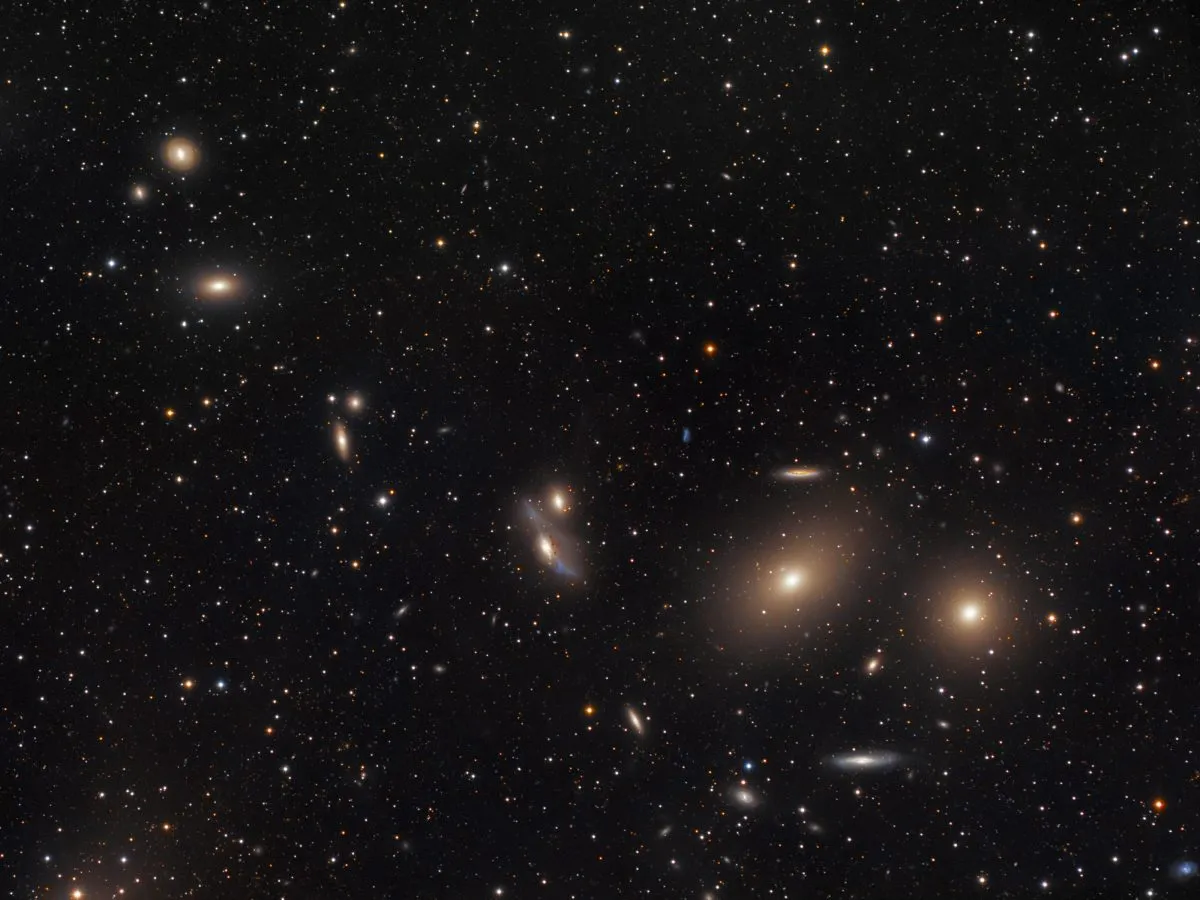
- Download our May 2023 binocular tour form (PDF)
1 - M53
A degree northeast of mag. +4.3 Diadem (Alpha (α) Comae Berenices), you’ll find a small misty patch which appears to grow in size and brightness if you centre it in the field of view then avert your gaze back to Diadem.
The apparent changes, which are typical of globular clusters, demonstrate the difference between direct and averted vision. Practice this technique; you’ll need it later when we seek out the galaxies in Markarian’s Chain
2 - FS Comae
Navigate to a point half-way between Diadem and mag. +4.2 Beta (β) Comae Berenices, then another degree to the west to an orange star, FS Comae, shining somewhere around mag. +6.
The magnitude of this semi-regular variable star varies between mag. +6.1 and + 5.3, with a period of 55–58 days. Analysis of the star’s spectrum reveals variations in radial velocity of the star’s surface, which indicates that its variability is due to pulsations in size.
3 - 28 &29 Comae
Head 5° northwest of mag. +2.8 Vindemiatrix (Epsilon (ε) Virginis) to a pair of white stars separated by half a degree and orientated roughly north–south. The southerly one is mag. +6.4 28 Comae, brightest of a little parallelogram of stars.
Mag. + 5.7 29 Comae is the brightest of a triple star group. The brighter (mag. +8.6) companion is 5 arcminutes back towards 28 Comae, and the fainter (mag. +9.9) one is an arcminute closer.
4 - Ceres
Ceres was discovered by Guiseppe Piazzi on the first day of the 19th century and is the only dwarf planet visible in standard binoculars.
It fades from mag. +7.8 to mag. +8.4 during the month, but should be easiest to detect around mid-month when the Moon is out of the way and it is 2.2° east of mag. +2.1 Denebola (Beta (β) Leonis).
5 - M49
Locate mag. +4.9 Rho (ρ) Virginis and place it on the northeast of your field of view. On the opposite side you should find a pair of sixth-magnitude stars, a little more than a degree apart and orientated southeast–northwest.
M49 is the small, slightly oval patch of light between these two. Use averted vision to see how many more galaxies you can detect in this region of sky.
6 - Markarian’s Chain
TTheis chain of galaxies known as Markarian's Chain, which you may already have detected north of M49, lies almost exactly half way between Vindemiatrix and Denebola.
Starting with M84 and M86, you should be able to identify at least the seven brightest galaxies in the chain.
6 binocular night-sky targets for April 2023
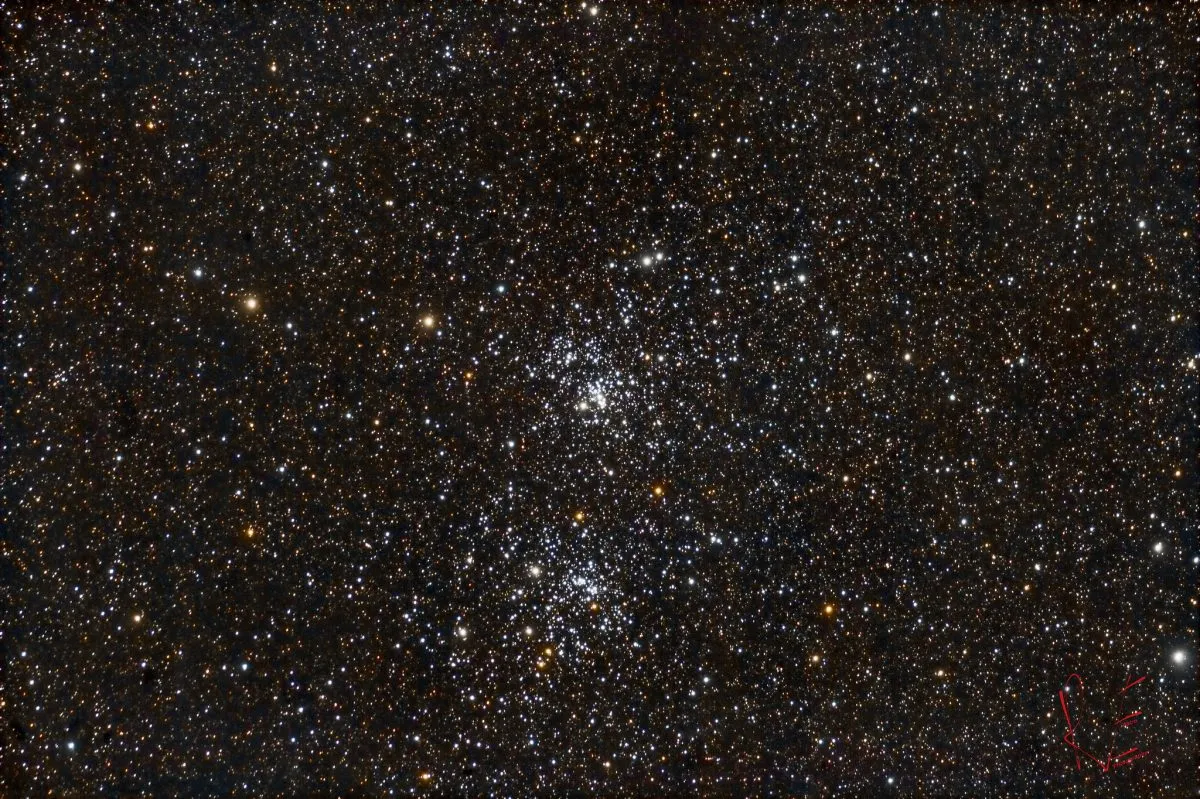
- Download our April 2023 binocular tour form (PDF)
1 - The Double Cluster
Half way between mag. 2.6 Ruchbah (Delta (δ) Cassiopeiae) and mag. +2.9 Gamma (γ) Cassiopeiae you will find a close pair of open clusters. These are known as the Double Cluster.
In a rural sky, you can see them with your naked eye as a distinctly elongated smudge of light, but binoculars will reveal two little concentrations of stars. Those stars are intrinsically extremely bright: if the Sun was there, it would be too faint for you to see it in binoculars!
2 - Melotte 15
If you imagine that mag. +3.3 Segin (Epsilon (ε) Cassiopeiae) and mag. +4.6 Iota (ι) Cassiopeiae are two corners of an equilateral triangle, Melotte 15 is the third corner.
In 10x50 binoculars, you’ll see a large (20-arcminute) glow with a handful of brighter stars forming a V shape. If you have a UHC filter to hold over an eyepiece, you might see the nebulosity (IC1805, the Heart Nebula) that surrounds, and gave birth to, the cluster.
3 - Markarian 6
Markarian 6 lies slightly less than 1° to the south-southwest of Mel 15. It’s quite easy to miss, so we use larger binoculars. What you should see is an arrow of half a dozen ninth-magnitude stars pointing southwards.
Owing to its faintness compared to Mel 15, you might assume it is much further away, but at 1,600 lightyears it is actually just under a quarter of the distance.
4 - Pazmino’s Cluster
If you pan slightly more than 1.5° due west from mag. +4.3 CS Camelopardalis, you will find an unremarkable little trapezium of seventh and eigth-magnitude stars. This is Stock 23, also known as Pazmino’s Cluster.
Your binoculars should reveal that this is much more than a trapezium and you may be able to resolve about half a dozen stars against a faintly glowing patch of sky about 10 arcminutes in diameter.
5 - Kemble’s Cascade
On spring evenings, Kemble’s Cascade is near-horizontal in the sky, so this line of eighth-magnitude stars, with a brighter fifth-magnitude one in the middle, looks more like a wristwatch or bracelet opened out against the sky than a tumbling cascade.
To find it, extend a line from mag. +2.3 Caph (Beta (β) Cassiopeiae) to Segin the same distance to the central bright star.
6 - Beta Cam
You can see mag. +4.0 Beta (β) Camelopardalis with the naked eye, and its mag. +7.4 companion, which lies 84 arcseconds southwest is easy to distinguish, even in small binoculars.
Beta Cam is a yellow supergiant in transition between being a hot new blue star and a much cooler red supergiant. It sometimes flashes, probably due to the equivalent of huge solar flares.
